- Refined, efficient and punchy diesel engine
- Sharp pricing and equipment list
- Plush interior
- Lack of third row airbag coverage
- Some practicality niggles in the interior
- Expensive to service
20 years ago, the average Australian family car was probably a large sedan, or if extra bootspace was required, a wagon and large SUVs were only starting to appear. Fast forward 20 years, and the large sedan and wagon barely sell at all. The quintessential family car of 2023 is an SUV – with families seemingly loving higher stance, large interior and the seven seats that many large SUVs have. Hyundai says it has the perfect answer to the SUV question: the 2023 Hyundai Santa Fe Highlander.
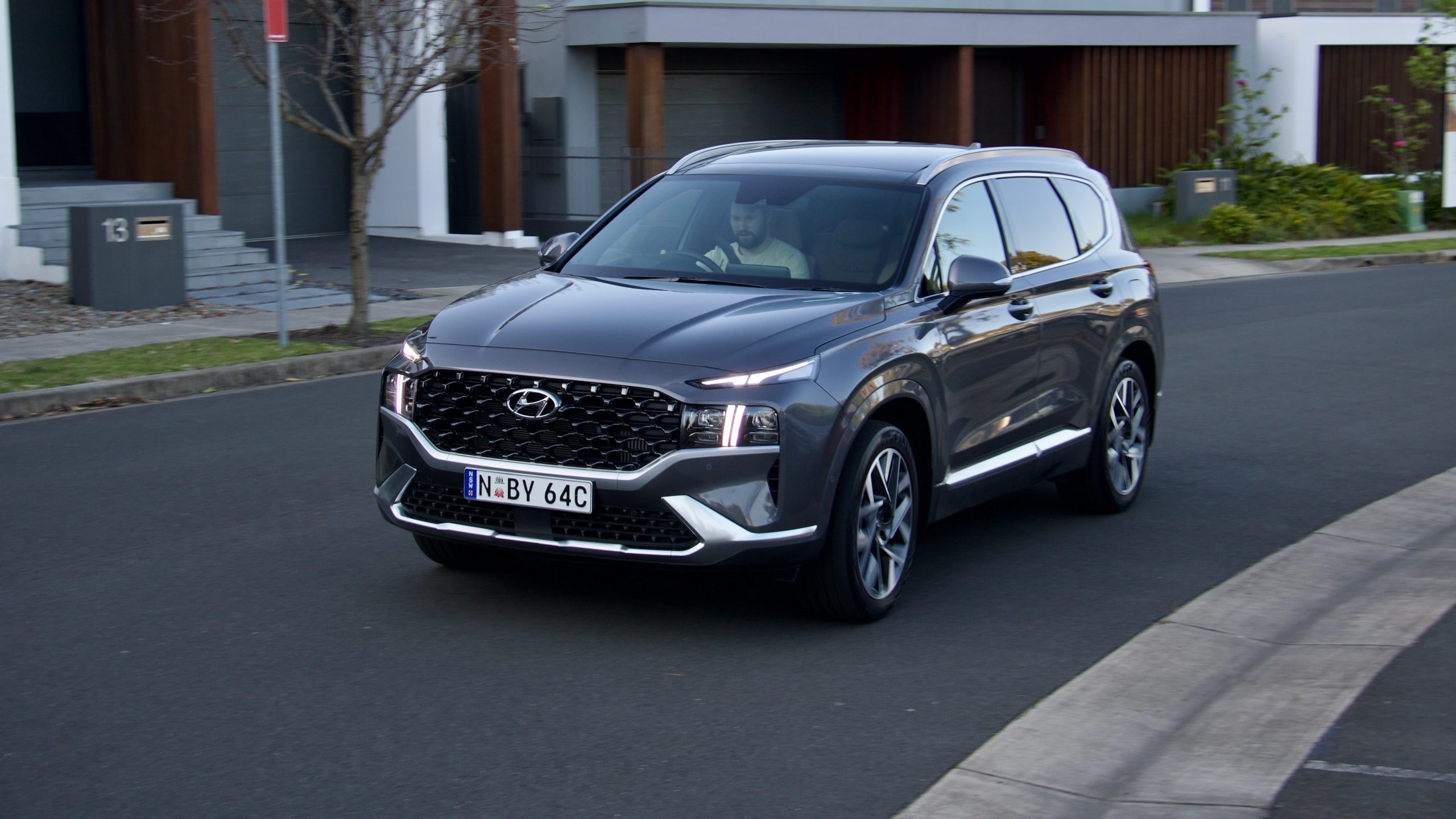
For the first years of the SUV craze, the Ford Territory, Holden Captiva and Toyota Kluger dominated the sales charts, but the Territory and Captiva are long gone and while the Kluger soldiers on, there are no shortage of choices for large family oriented seven-seater SUVs on the market today. Amongst the sea of options is the Hyundai Santa Fe, one of two large SUVs produced by Hyundai. Now in its fourth generation, the current Santa Fe offers a choice of petrol, petrol hybrid and diesel drivetrains in Australia – the latter two being important to many against the current backdrop of rising petrol prices. We’ve spent a week behind the wheel of the range-topping Highlander Diesel to see if it’s the family car for you.
Price & Equipment: 8.5/10
The 2023 Santa-Fe range starts at $46,050 plus on-road costs, or around $50,500 drive away, depending on location, and it tops out with the Santa Fe Hybrid Highlander 7 Seat for $69,550, or around $75,200 drive away, depending on location. Our top-spec Highlander, with the diesel engine, premium paint and tan interior and costs $67,540 +ORC, or around $73,100 drive away depending on location.
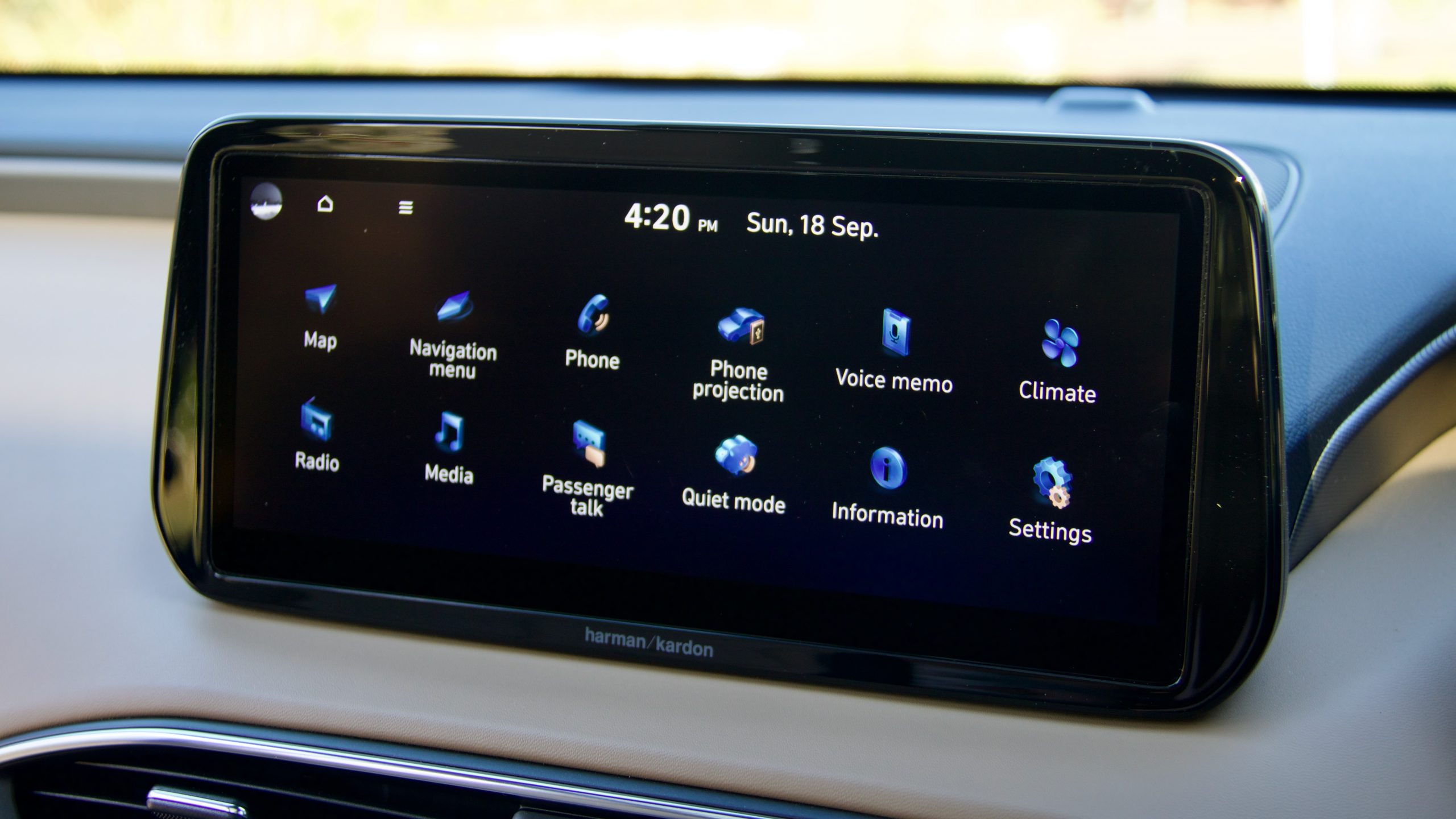
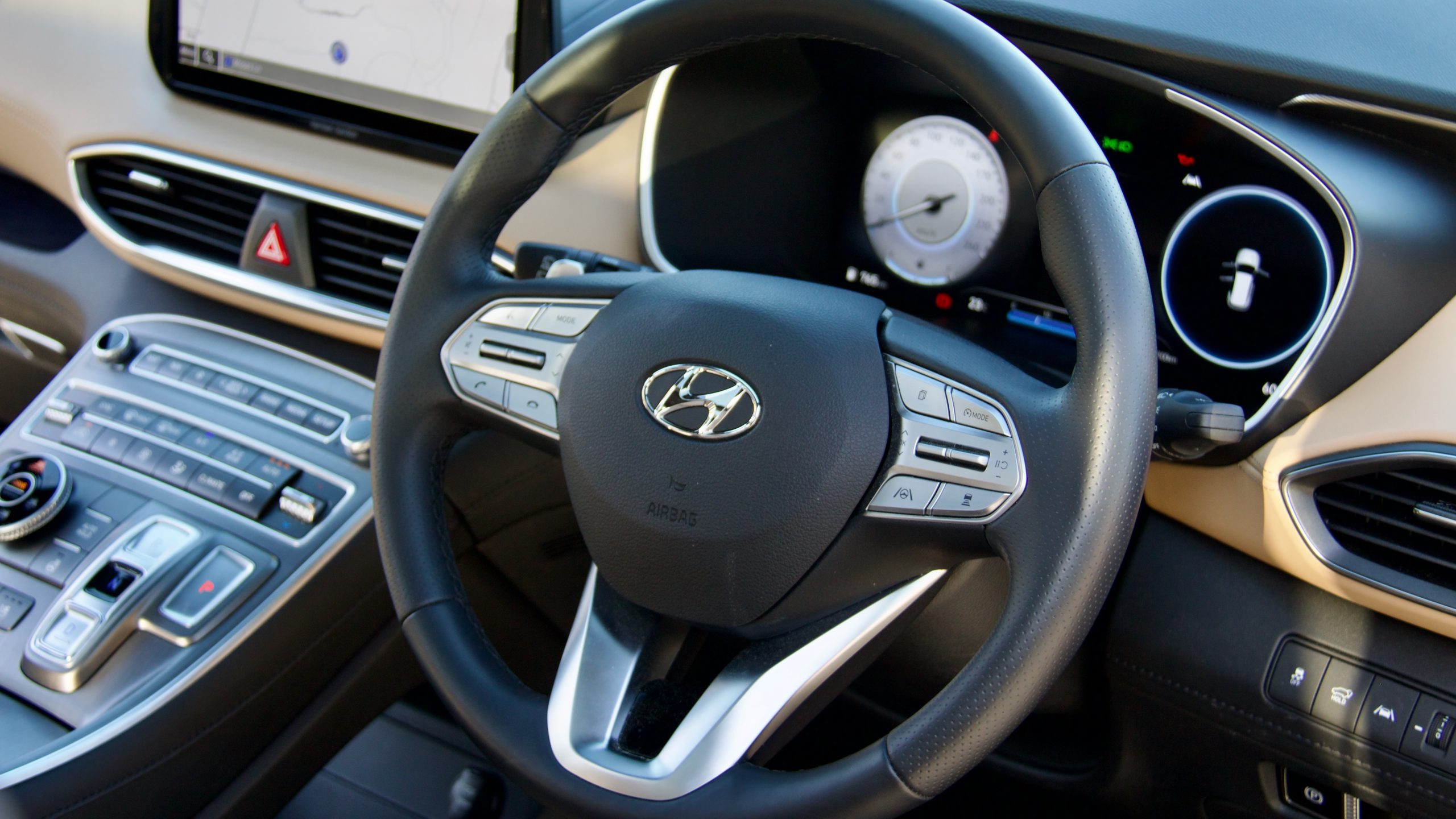
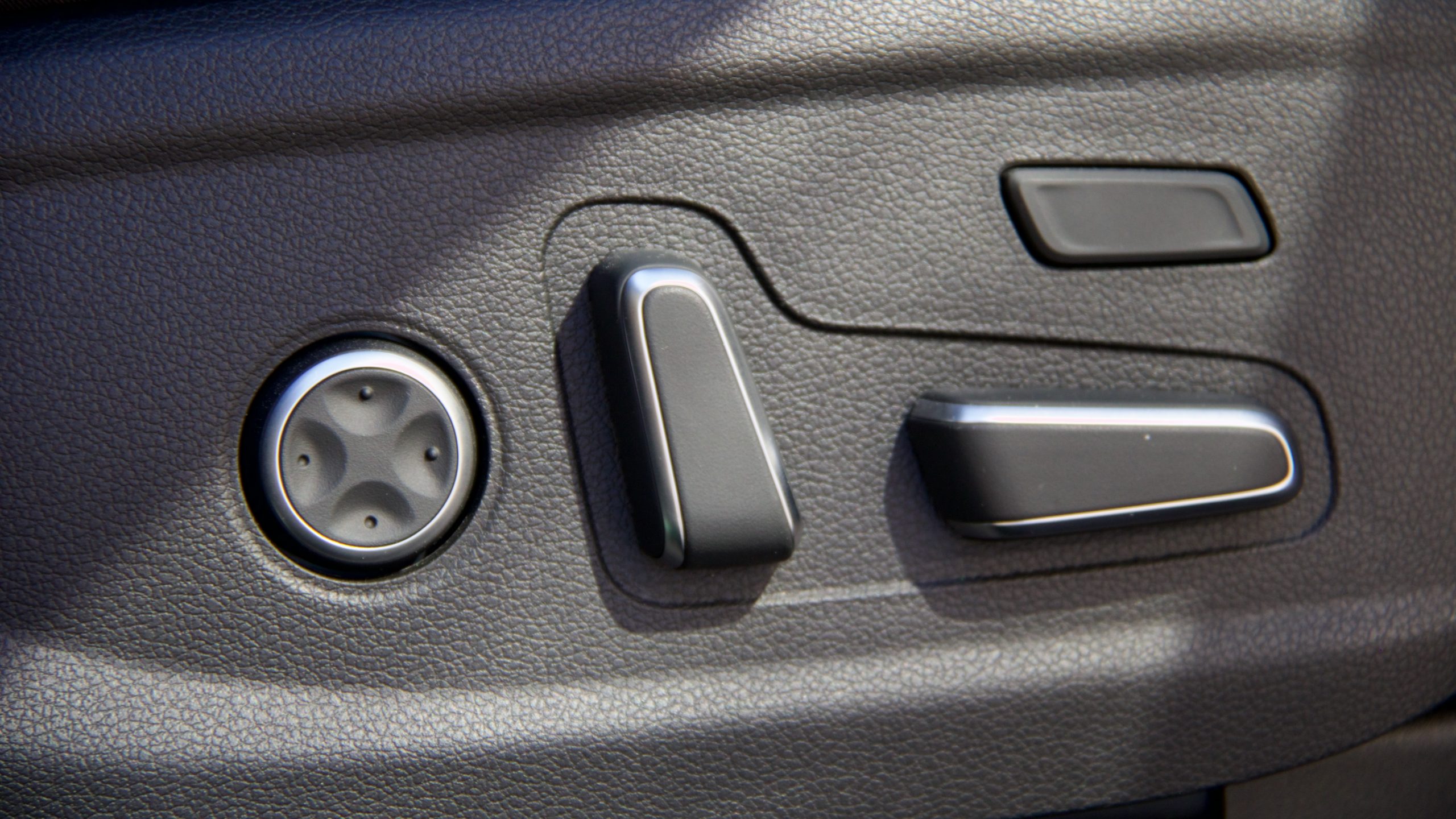
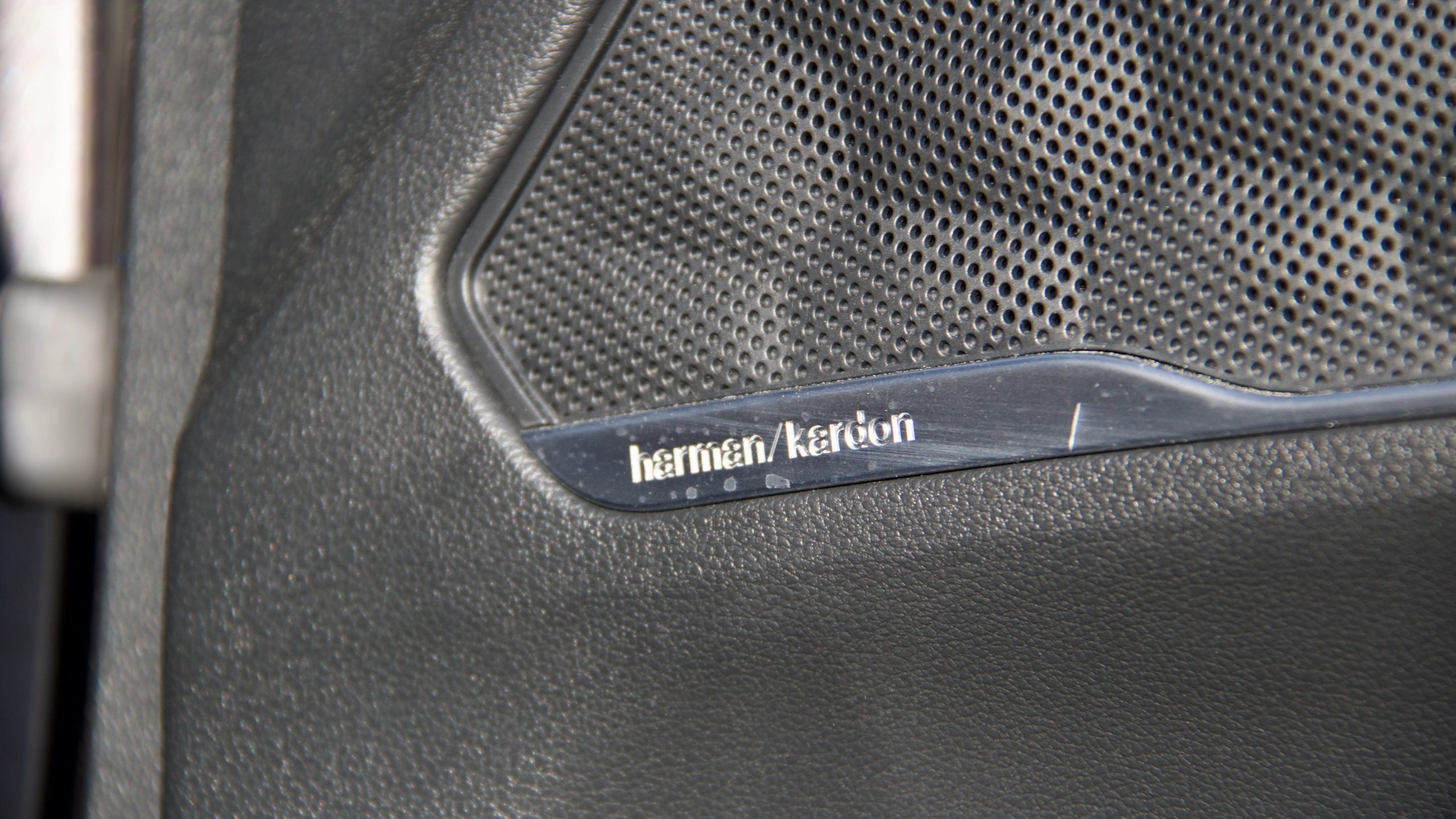
For the money, standard equipment includes 20-inch alloy wheels, automatic all-LED lighting, roof rails, heated/auto-folding mirrors which dip while reversing, rain-sensing wipers, keyless entry and start with remote start and smart parking assistance through the smart key, paddle shifters, an auto-dimming rearview mirror, a panoramic sunroof, customisable ambient lighting in the front row, retractable sunshades for the second row, a 12.3-inch digital instrument cluster, a heads-up display (HUD), Nappa leather upholstery, heated and ventilated front and second row outbound seats with memory and 14 ways of power adjustment for the driver’s seat plus eight ways of adjustment for the passenger, a 10.25-inch touchscreen with AM/FM/DAB radio, wired Apple CarPlay and Android Auto, satellite navigation, a Harman Kardon 10 speaker audio system, seven USB ports, a wireless phone charger, dual-zone climate control with vents in the second and third row and a manual fan speed control for the third row.
Achieving a five star ANCAP rating back in 2018, safety equipment includes seven airbags (dual frontal, dual front side, front centre and curtain airbags for the first and second row), front and rear parking sensors, auto emergency braking (AEB) with pedestrian, cyclist and intersection assist, blind-spot monitoring with braking, a blind-spot camera, rear cross-traffic alert with braking, lane keeping and tracing assistance, driver attention monitoring, auto high beam, rear auto breaking, a 360-degree camera, adaptive cruise control with stop and go functionality, speed sign recognition, safe exit assistance, rear occupant alert, a tyre pressure monitoring system and a burglar alarm.
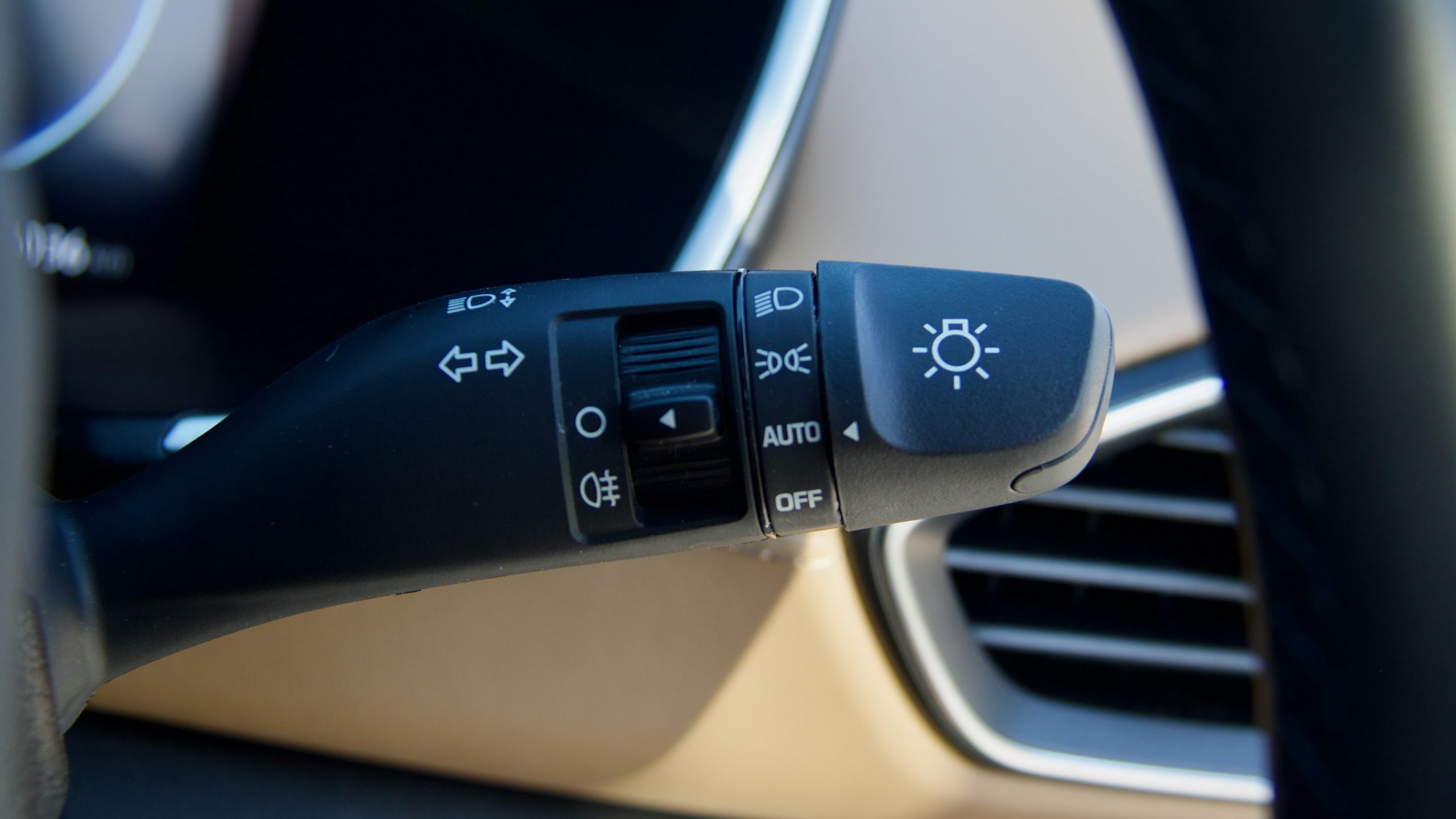
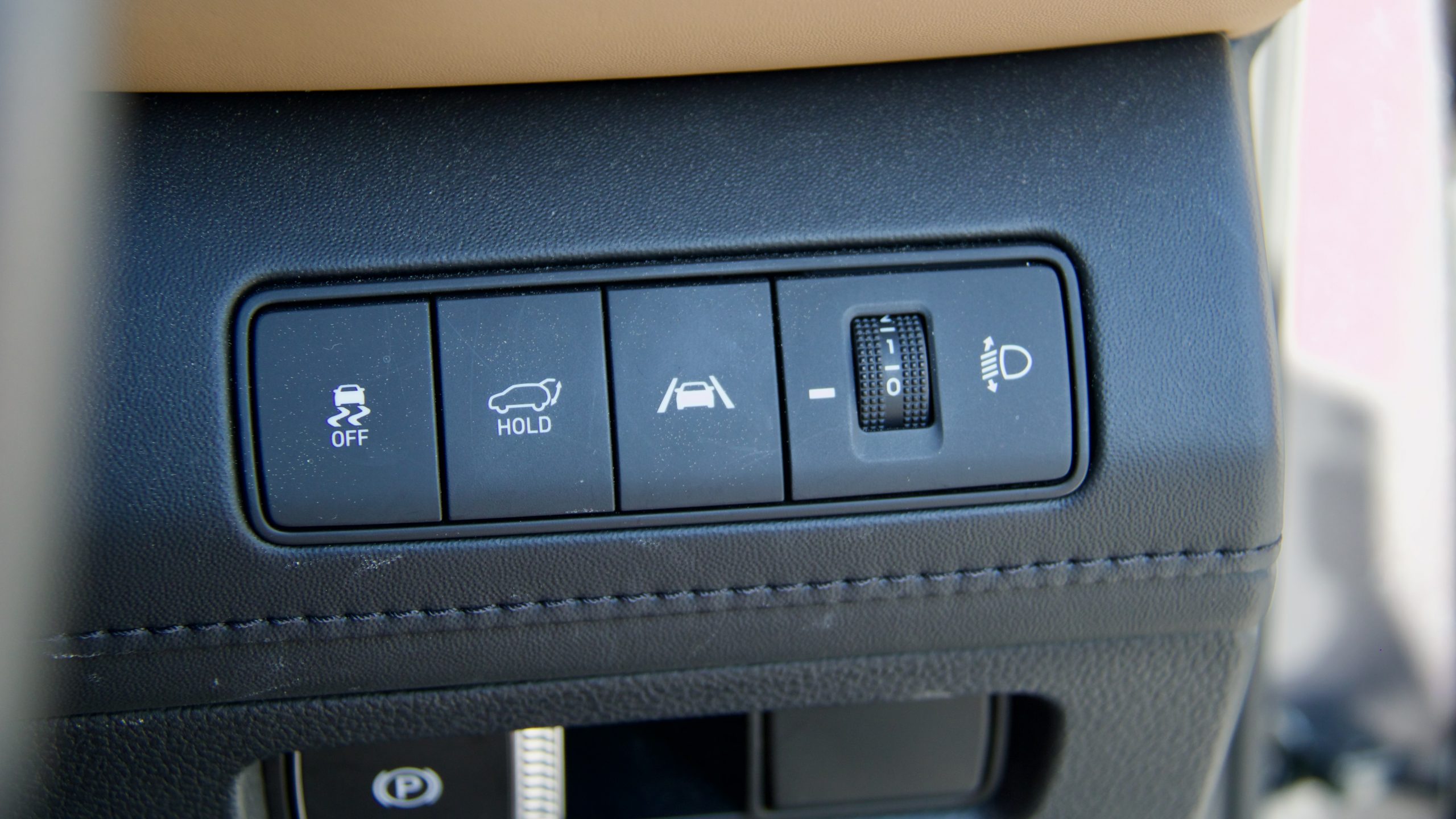
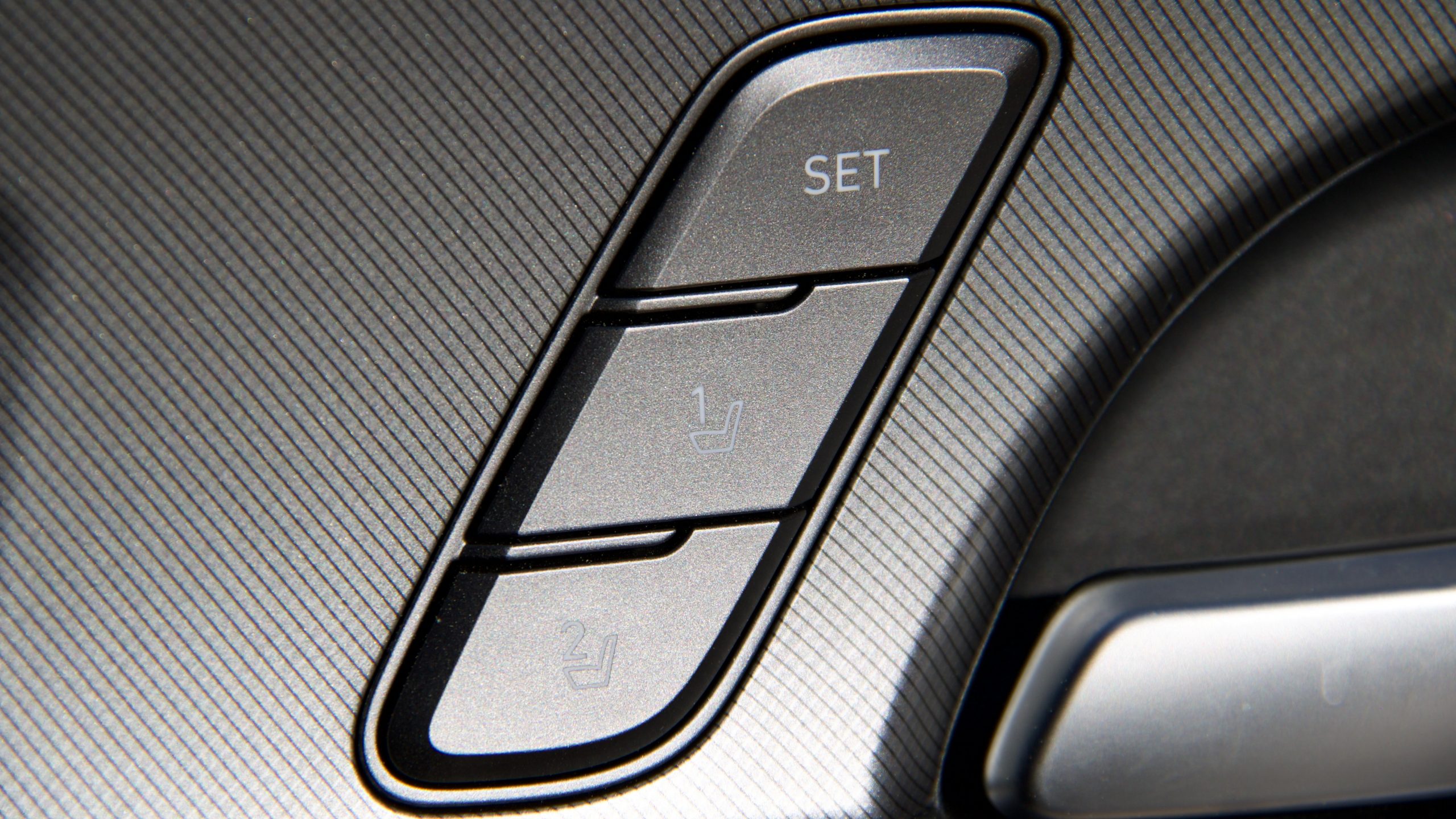
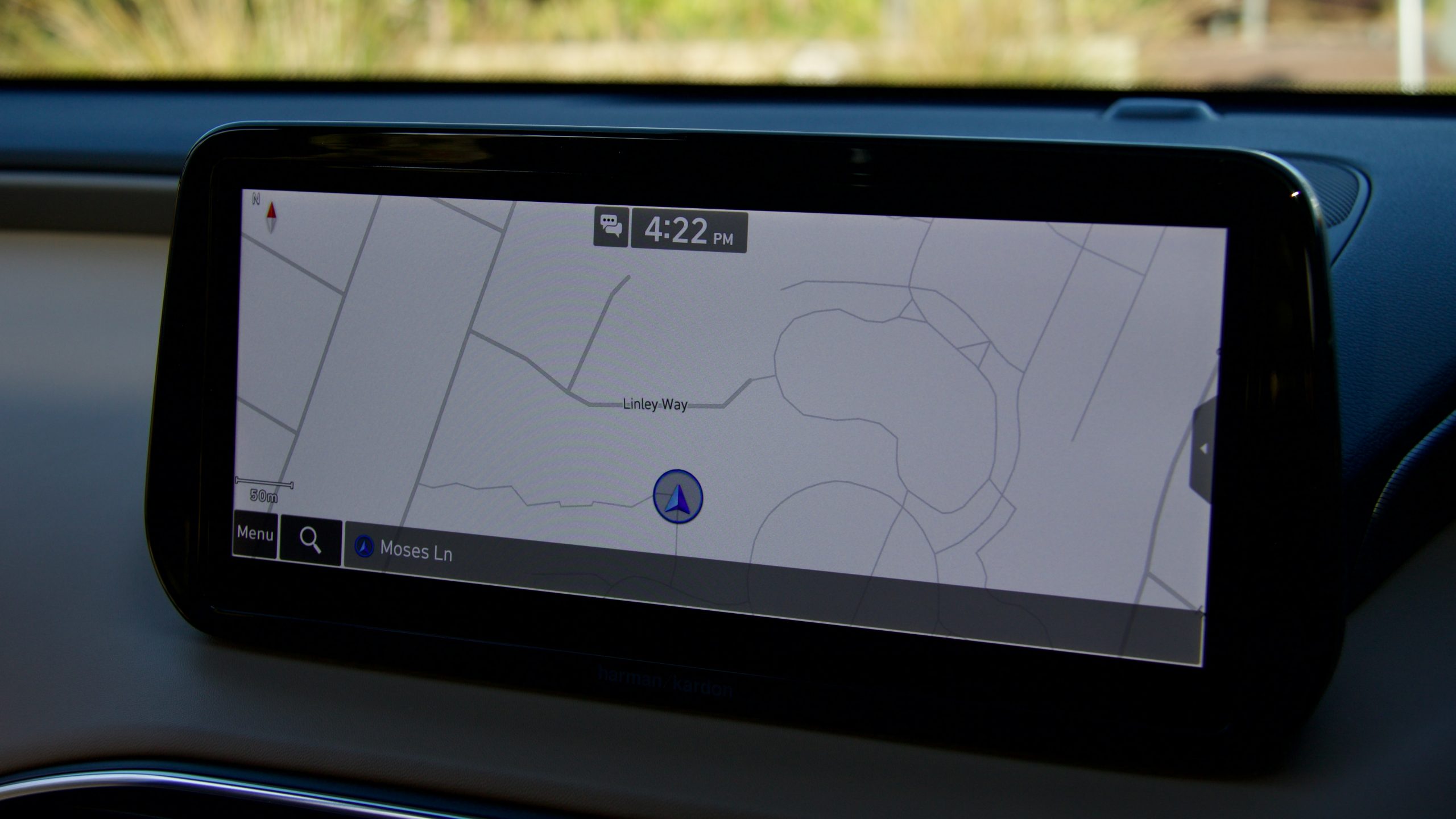
Options for the 2023 Hyundai Santa Fe Highlander AWD Diesel are limited to exterior colours and interior trim choices. Buyers are offered a narrow choice of four colours: ‘Glacier White’ is the sole non-cost option, with ‘Abyss Black’, ‘Typhoon Silver’ and the ‘Magnetic Force’ colour our test car was finished in all attracting a $695 premium. Two interior trim options are offered – ‘Black Nappa Leather’ or the ‘Camel Beige Nappa Leather’ finish our test car was optioned in for an extra $295.
Buyers have no end of alternative large seven seat SUVs, such as the Skoda Kodiaq, Volkswagen Tiguan Allspace, Toyota Kluger, Kia Sorento, Mazda CX-8 and CX-9, Jeep Grand Cherokee L and the Nissan Pathfinder. We picked out the Mazda CX-8 Asaki Diesel AWD, priced around $75,000 drive away and the Toyota Kluger GXL Hybrid AWD, priced around $73,500 drive-away as being two of the closest competitors to the Santa Fe Highlander Diesel AWD.
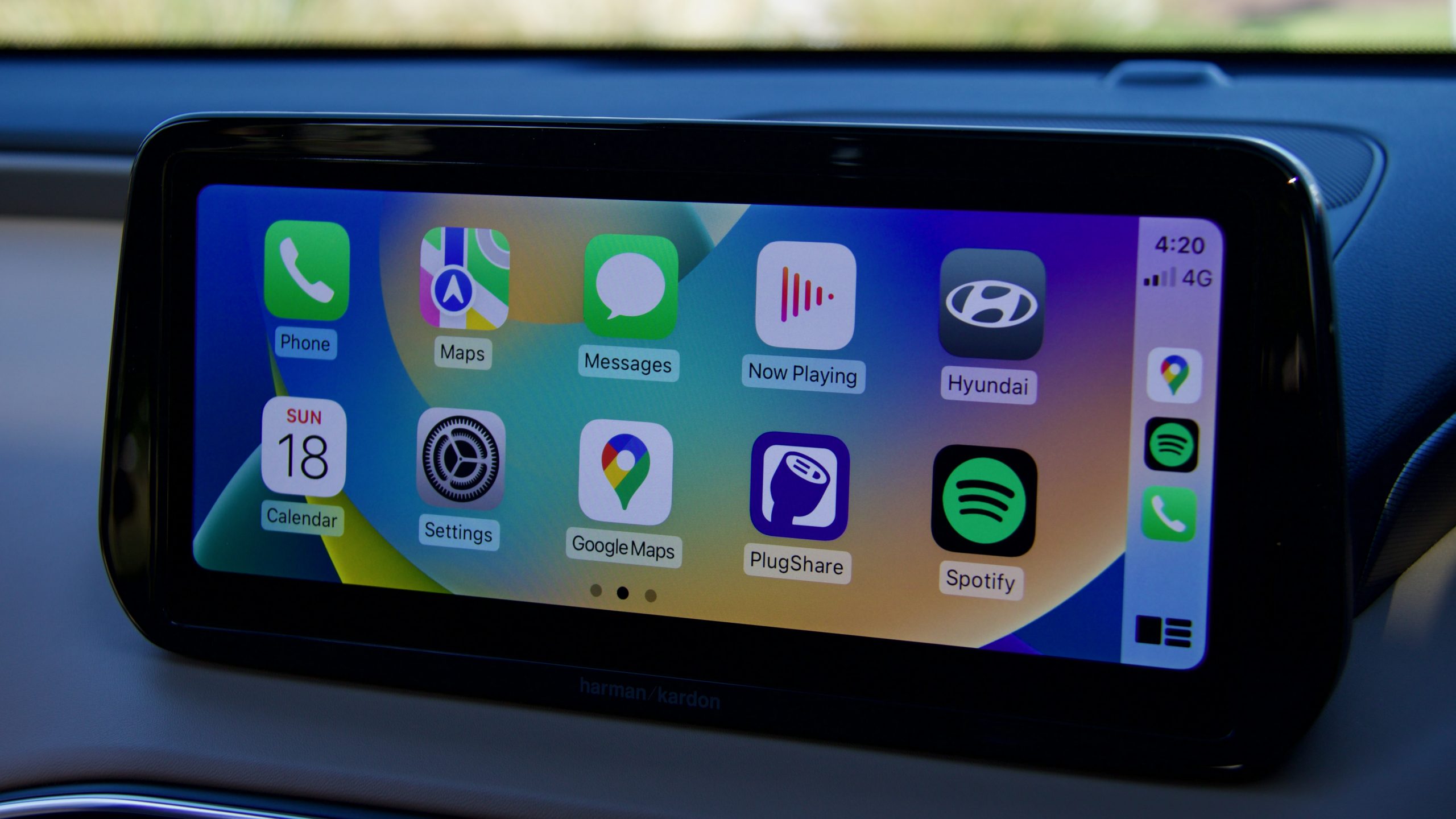
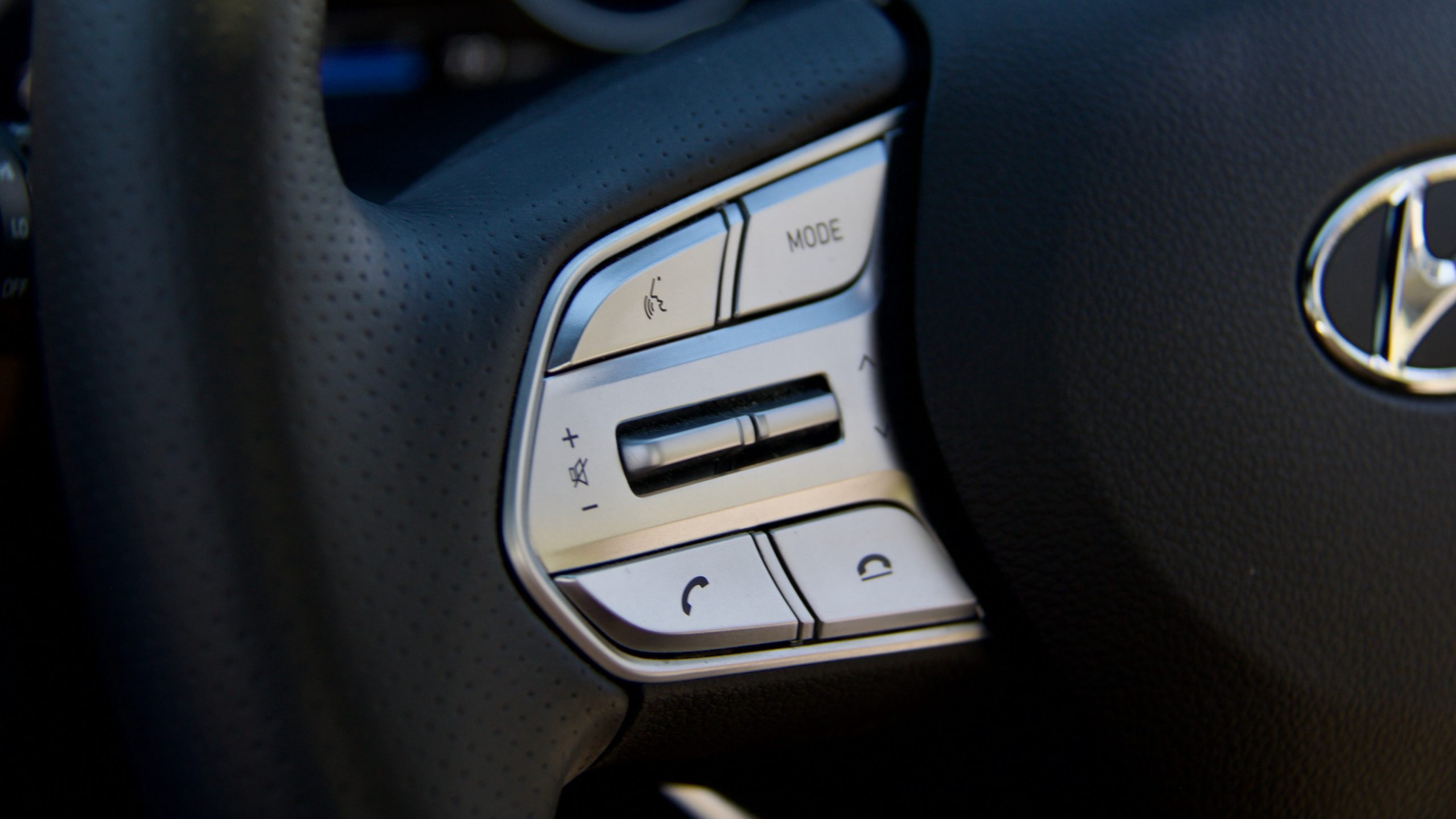
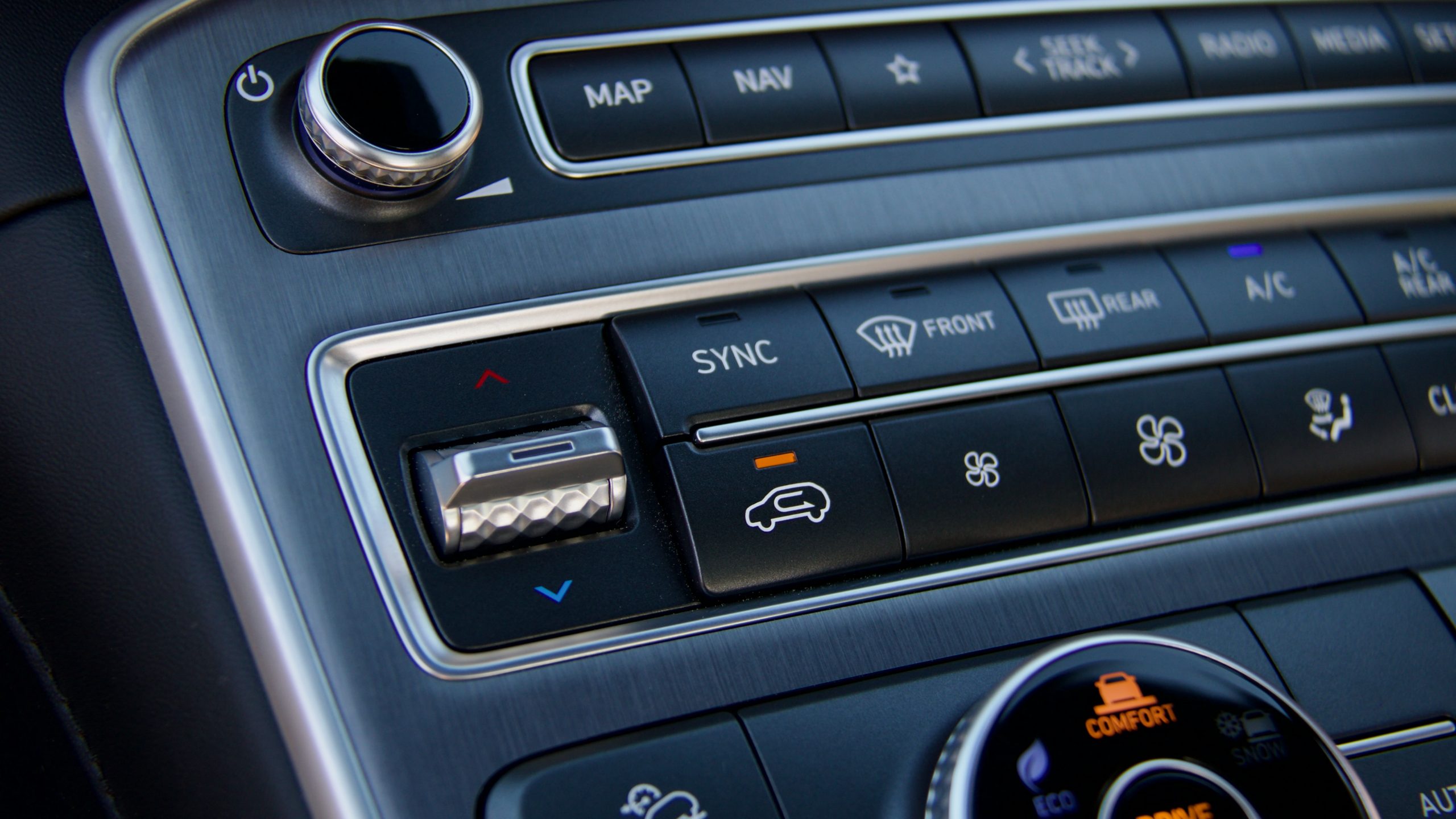
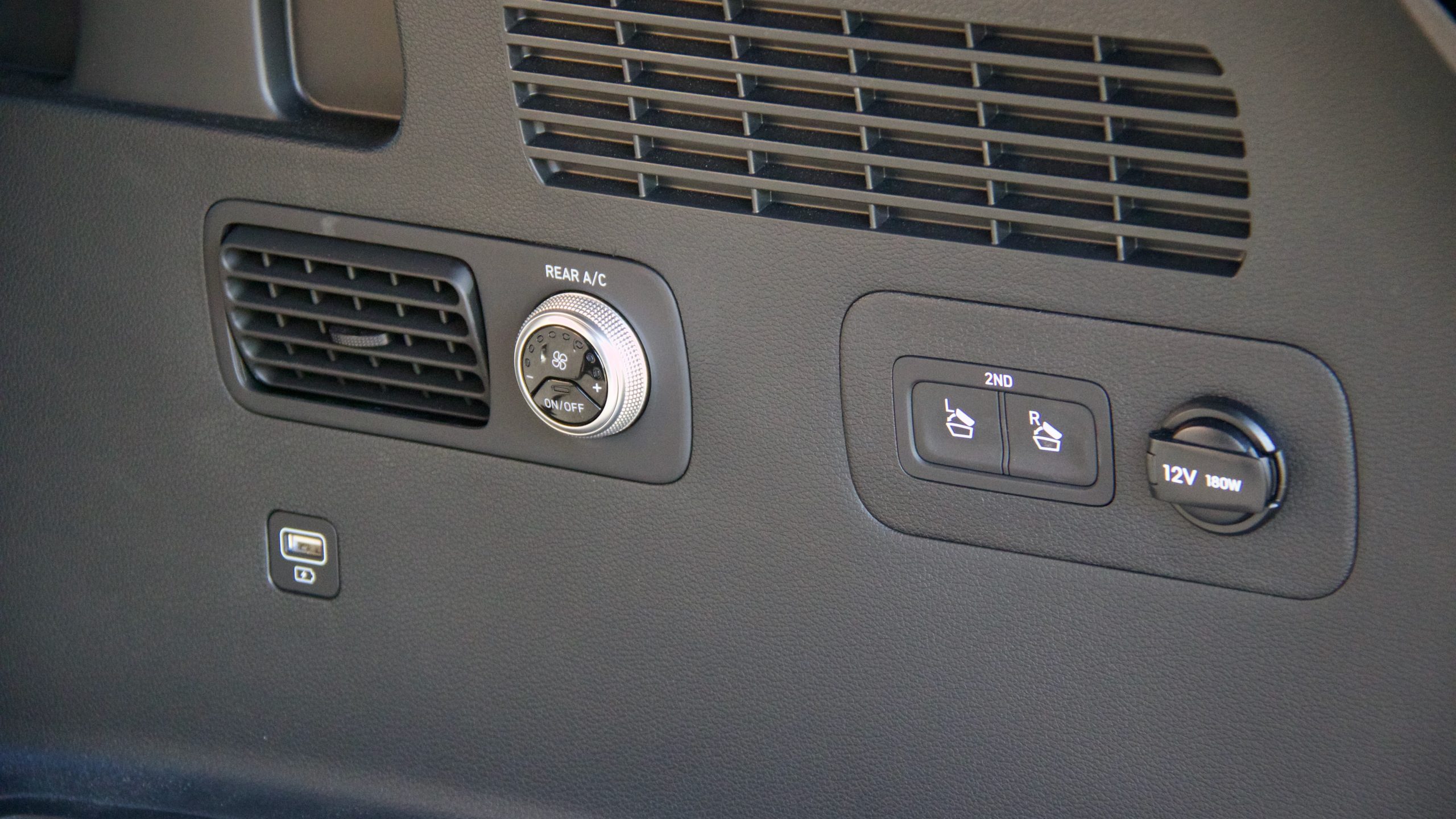
Compared to the CX-8, the Santa Fe is well featured with larger 20-inch wheels, remote start and parking assist, multi-collision braking, blind spot and rear cross traffic collision avoidance, a blind spot camera, front cross traffic alert and advance system, safe exit assist, an additional two sensors for both the front and rear sensors, a centre airbag, an anti-theft alarm, an additional fours ways of adjustment for the driver seat, an additional two ways of adjustment for the passenger seat, a panoramic sunroof versus the standard sunroof in the CX-8, a larger 12.3 inch digital instrument cluster and fog lights. The CX-8 counters with Matrix LED headlights, an additional zone of climate control, wireless Apple CarPlay and Android Auto and airbag coverage for the third row.
The Santa Fe, being a top-spec model, also has a substantial of equipment that’s missing from the midrange Kluger GXL, including rain-sensing wipers, paddle shifters, multi-collision braking, blind-spot and rear cross-traffic collision avoidance, a blind-spot camera, rear collision avoidance, safe exit assistance, a 360 degree view camera, an additional two front and rear parking sensors, a tyre pressure morning system, a front centre airbag, an alarm, a premium sound system with an additional four speakers, Nappa leather over artificial leather in the Kluger, an extra six ways of powered adjustment for the driver’s seat, a wireless phone charger, a USB charger for the third row, a panoramic sunroof, a larger 12.3 inch digital instrument cluster versus the 7.0-inch semi-digital unit in the Kluger, a heads-up display, ventilation for the front seats, heating and ventilation for the second row outbound seats, ambient interior lighting, a 360 degree view camera, an electric tailgate and memory for the driver seat.
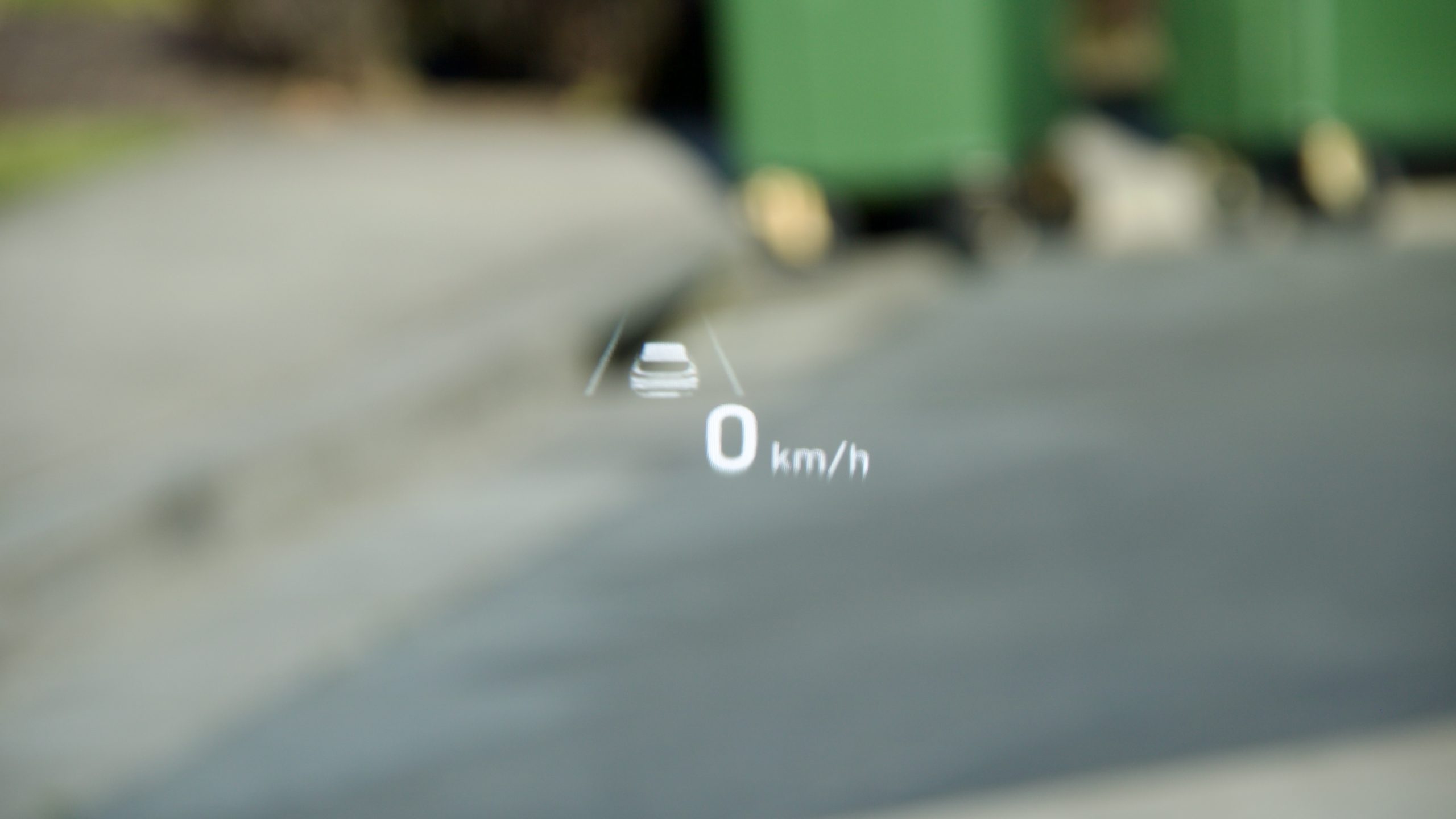
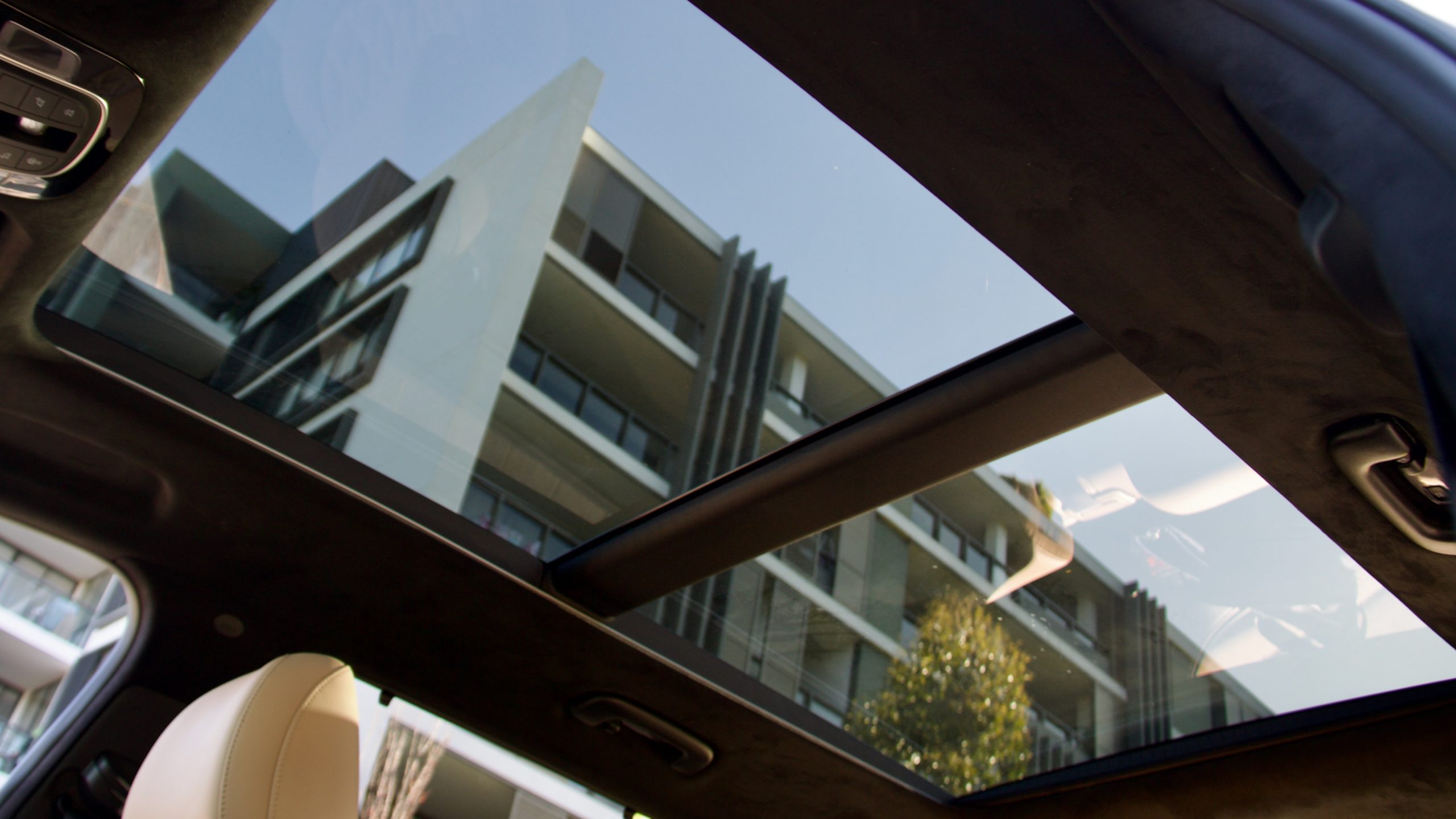
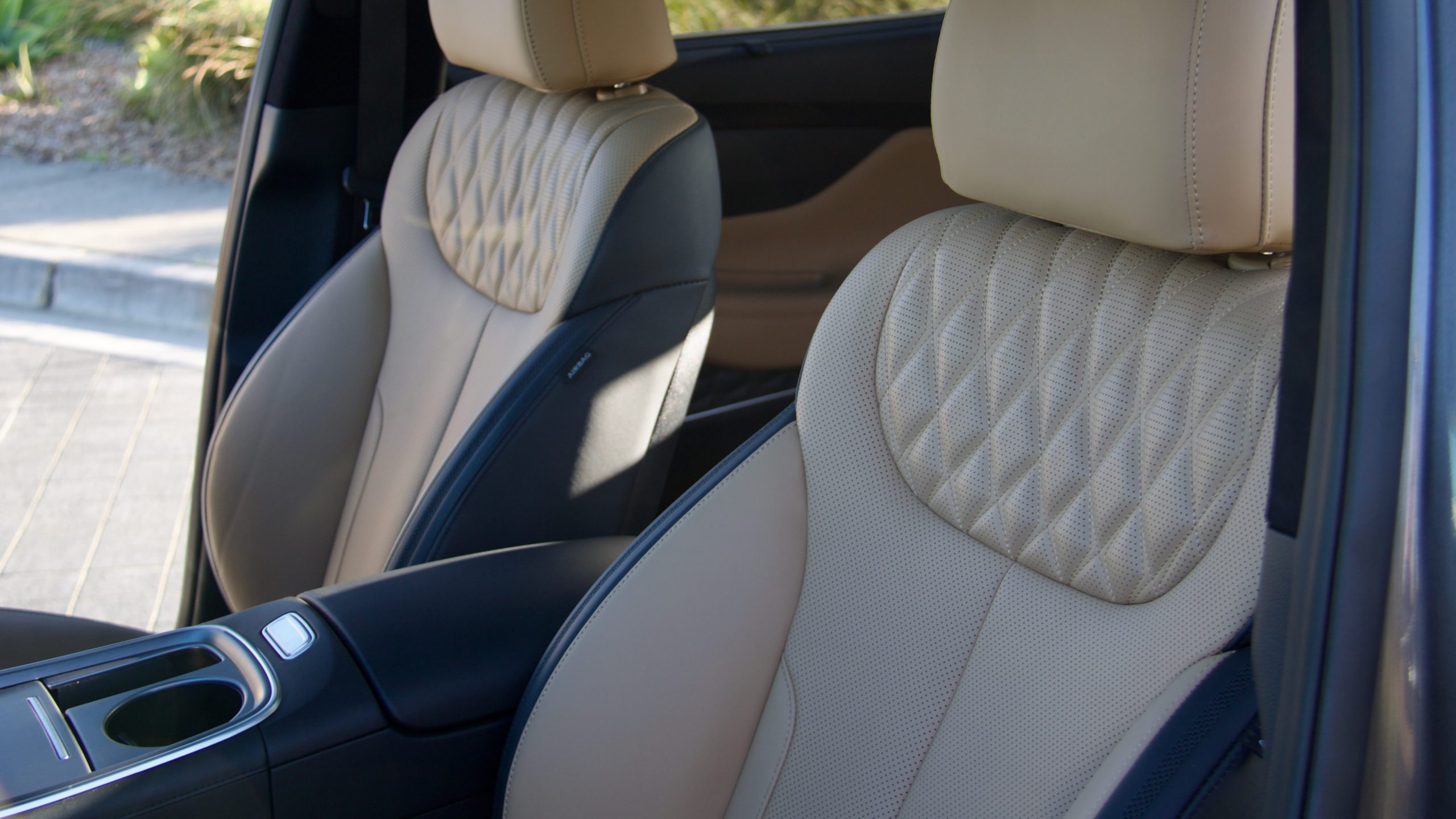
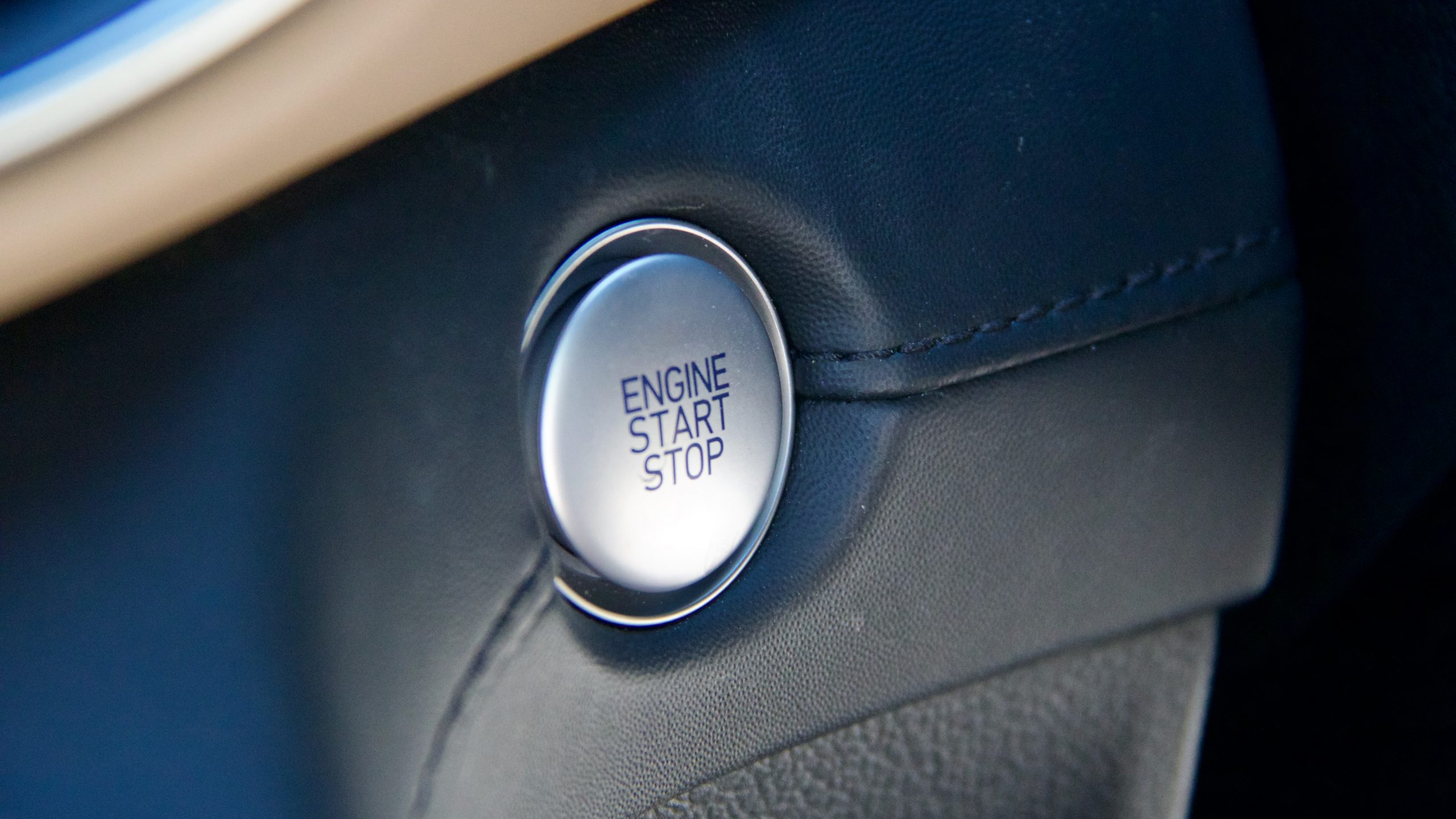
In return, the Kluger has an additional USB charging point up front, a separate climate zone for the second and third rows, a driver’s knee airbag, a larger 12.3-inch touchscreen, wireless Apple CarPlay, an inbuilt communication sim allowing for emergency call, collision notification and stolen vehicle tracking, along with subscription based remote vehicle functions.
The 2023 Hyundai Santa Fe Highlander Diesel AWD compares favourably equipment-wise to these two competitors, though the Kluger is a larger electric hybrid vehicle. In terms of what is missing, the biggest oversight is the lack of curtain airbag coverage to the third row of seats. Considering competitors such as the CX-9 and Kluger have had curtain airbags coverage for all three rows since 2007, it’s an unfortunate let down in what is generally a good safety package. Otherwise there isn’t much other equipment that we missed, though we’d like to see a third zone of climate control for the 2nd and 3rd row and wireless CarPlay and Android Auto.
Performance & Economy: 9/10
Buyers have a choice of three engines across the 2023 Hyundai Santa Fe lineup, including a petrol, hybrid petrol electric and diesel options. Our test covered the diesel option, which is a 2.2-litre four-cylinder turbo diesel engine that Hyundai refers to as the ‘Smartstream D2.2′. Developing 148kW of power at 3,800rpm and 440Nm of torque low in the rev range between 1,750rpm and 2,750rpm. Power is sent to all four wheels by an eight speed dual-clutch automatic transmission.
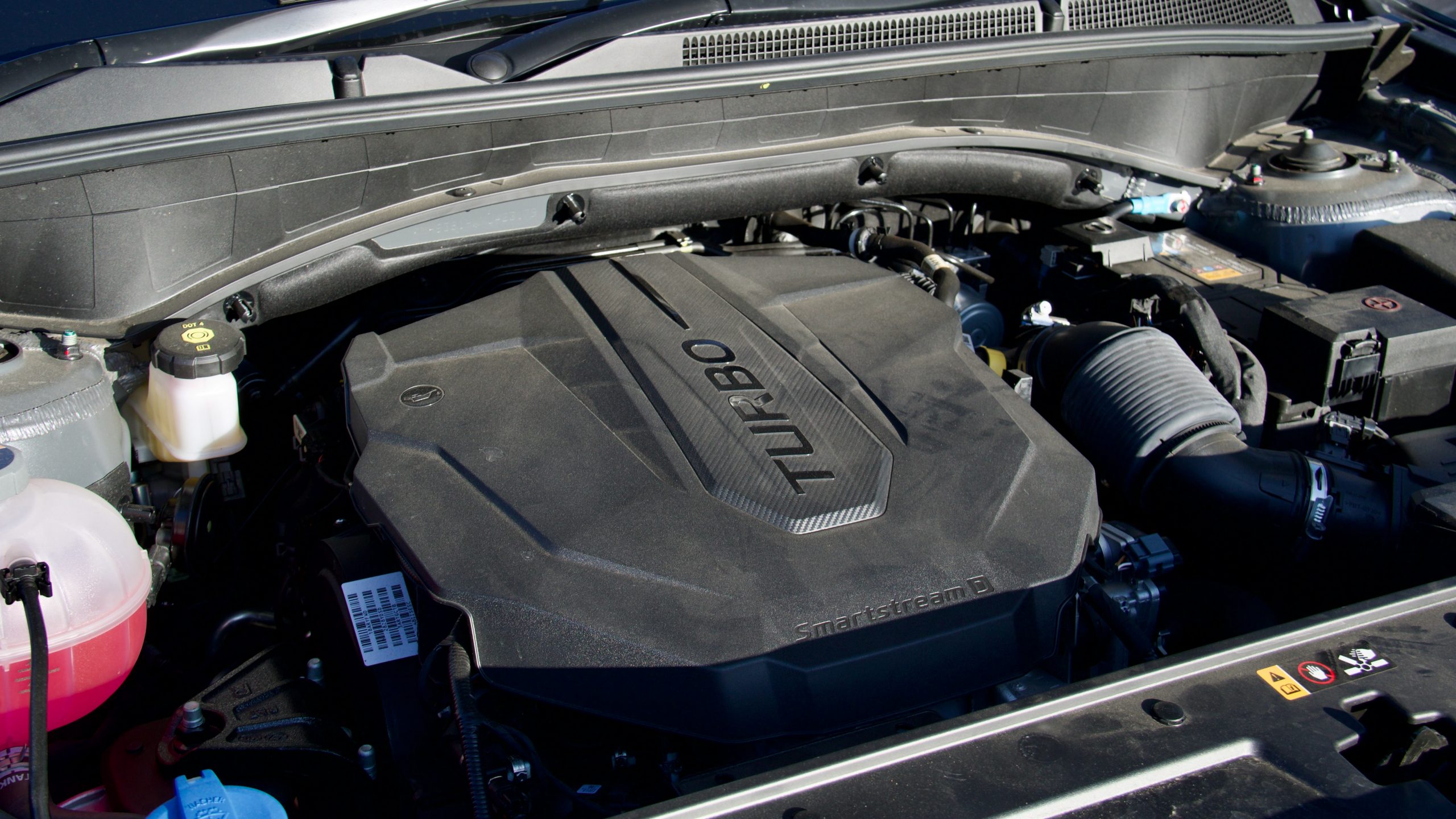
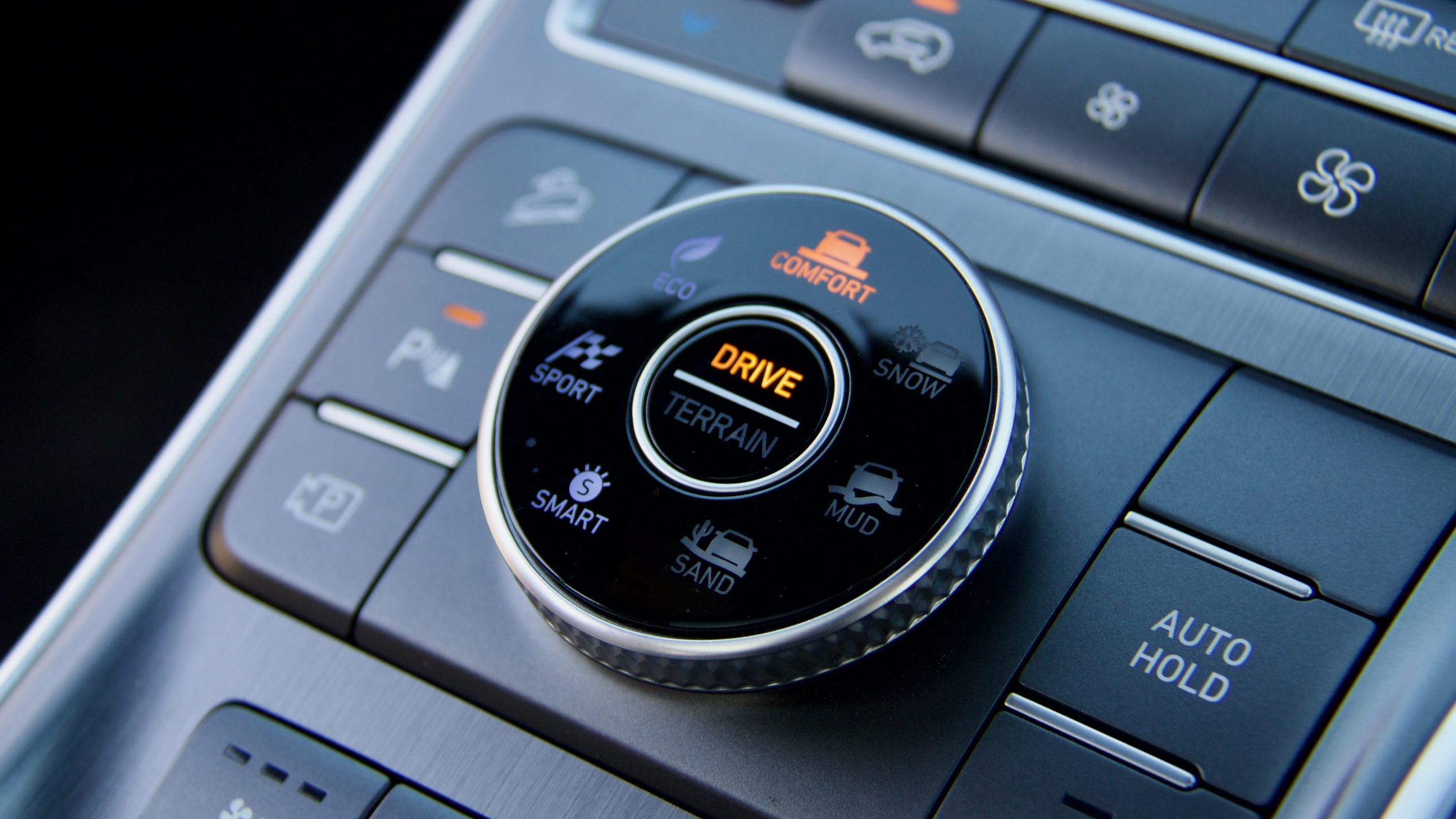
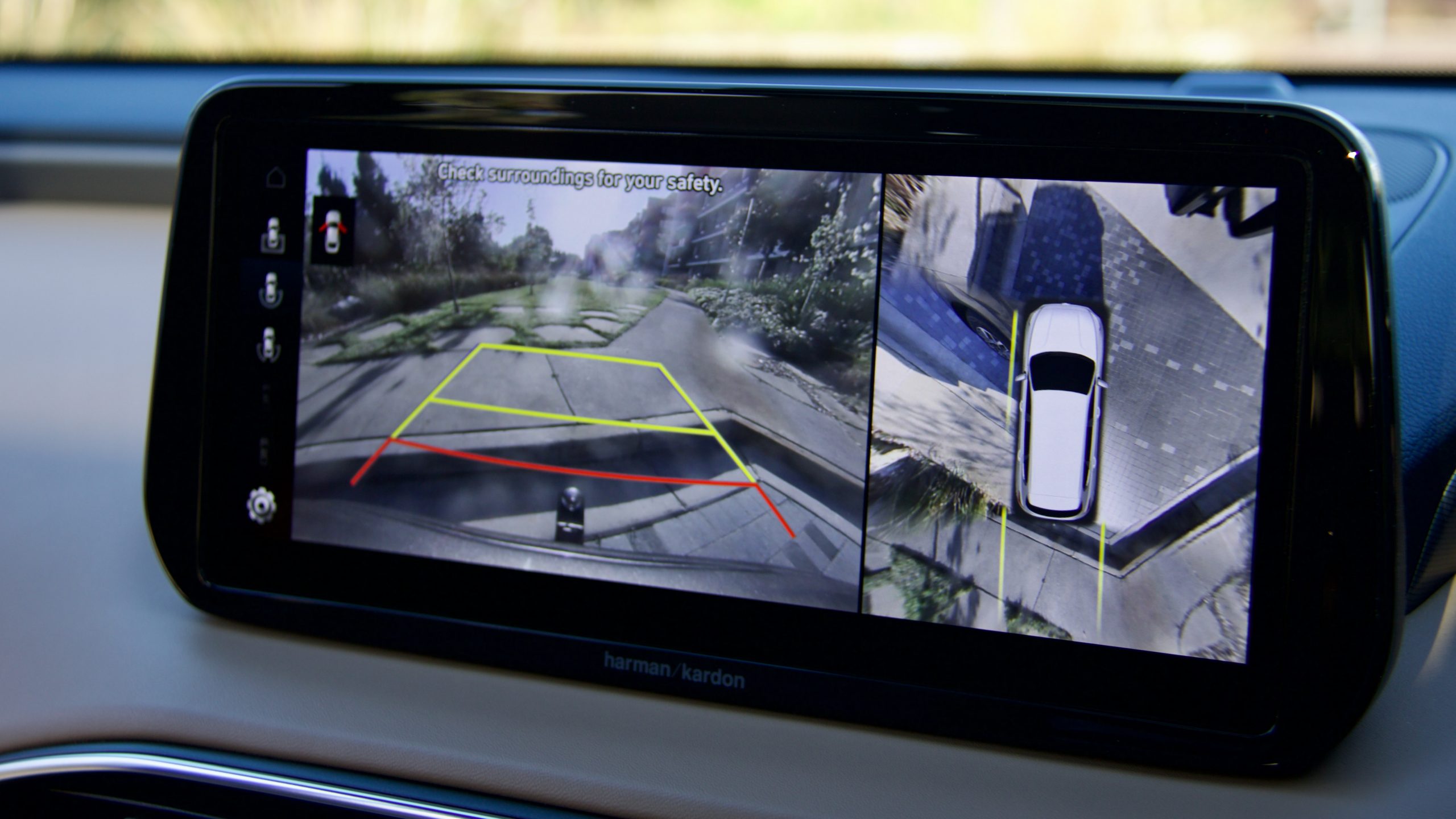
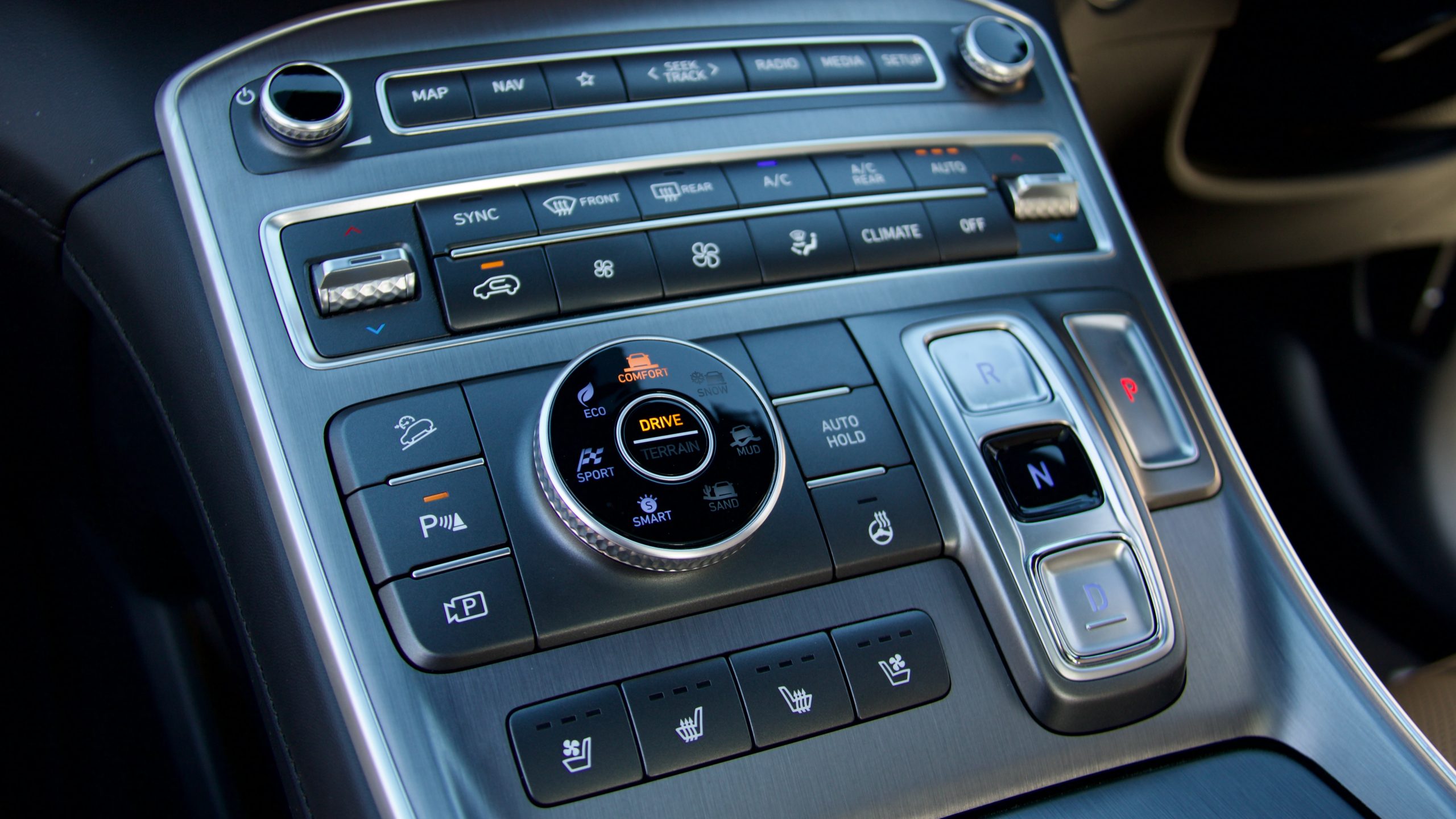
The engine is one of the most refined diesels we’ve tested, to the point that we questioned a few times whether or not we’d actually been given a petrol version by mistake. The excellent torque makes for a responsive drivetrain and combined with the reasonable power output makes light work of getting up to speed, zipping around suburbia. Highway cruising is also handled well by the Smartstream diesel, with ample power to overtake – though punching the accelerator does remind the driver that they are in fact driving a diesel vehicle.
The eight speed dual clutch transmission pairs very well with the engine, and is not only quick shifting, but is refined – kudos to Hyundai for creating an excellent dual-clutch transmission. Many other dual clutch setups feel jerky and unnatural at lower speeds, but Hyundai seem to have overcome this, creating an transmission that rarely ever gets caught out – it truly does feel like a smooth, faster shifting torque converter transmission.
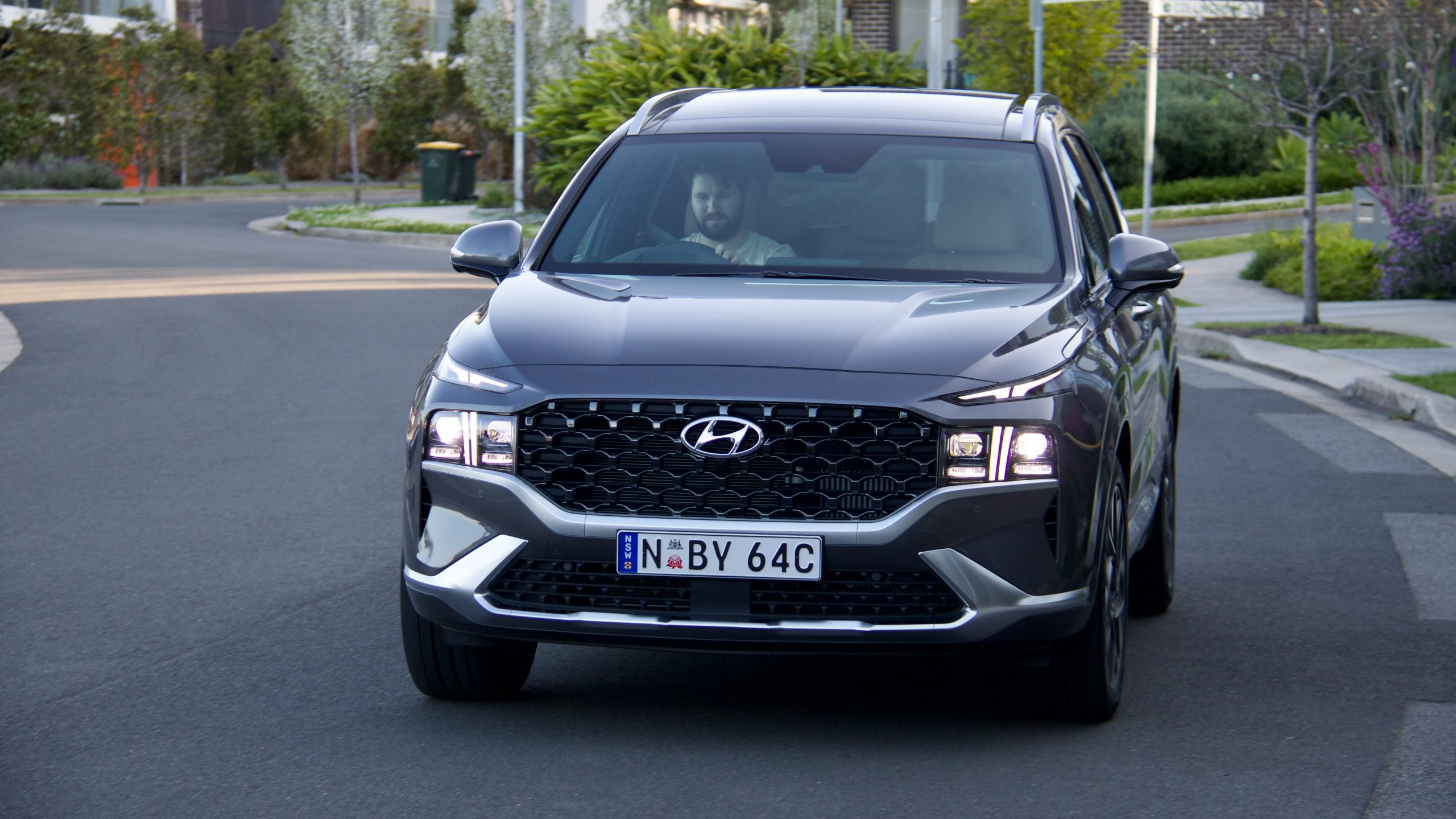
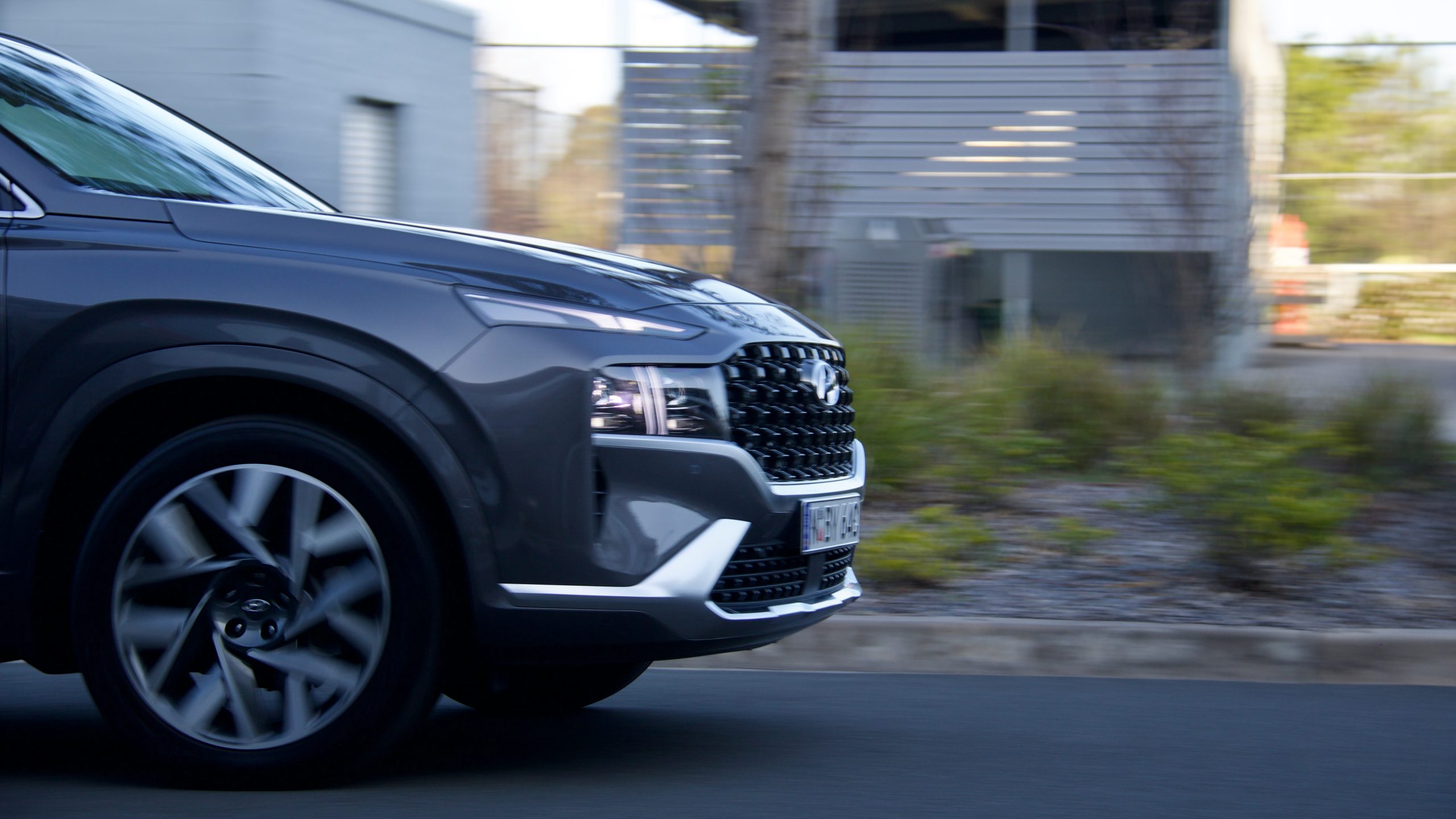
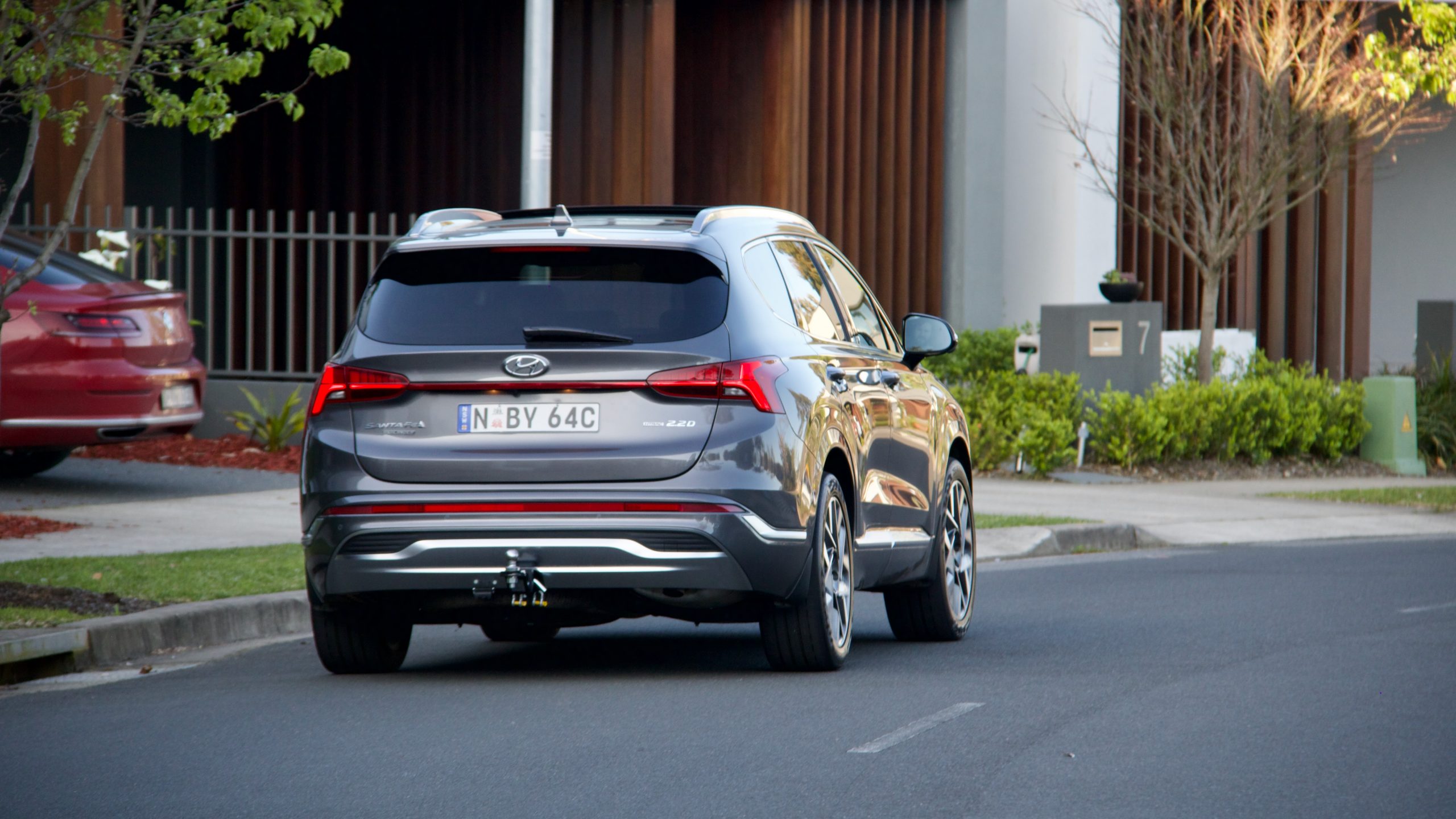
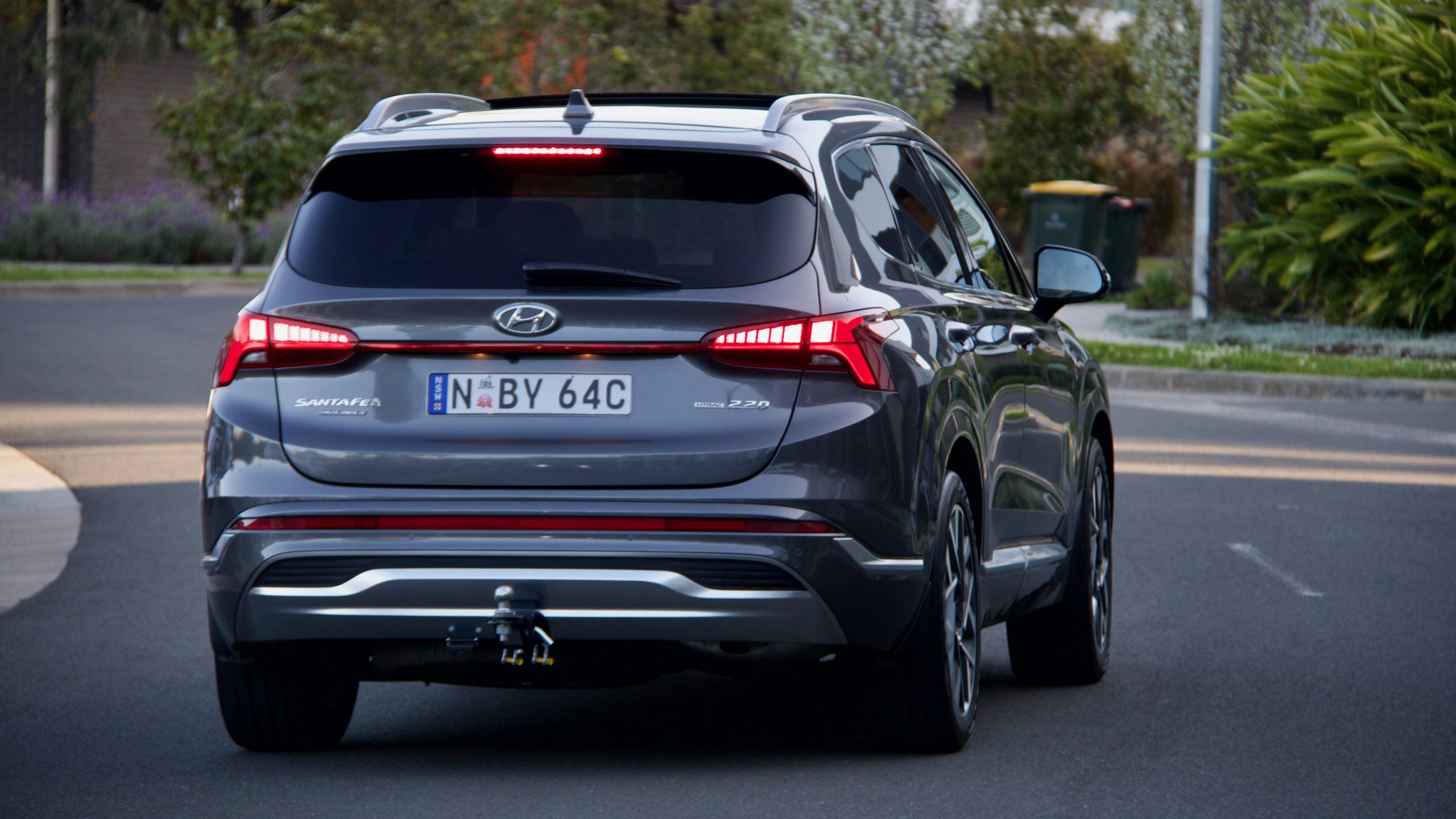
Across our week with 2023 Santa Fe Highlander Diesel AWD, we achieved fuel consumption of 7.1L/100km – not too far off Hyundai’s claim of 6.1L/100km and half as much as 14.2L/100km we’ve seen in the past testing a V6 petrol Santa Fe in similar conditions. Our testing of the CX-8 revealed a near identical 7.2L/100km, though the Kluger Hybrid bests both with a consumption of 5.4L/100km – though that would increase in out of town driving that diesels excel in. With the fuel consumption we returned and a full 67-litre tank, a cruising range of 940kms should be possible. Hyundai says the Santa Fe diesel emits 160 grams of CO2 per kilometre.
Ride & Handling: 8/10
Put simply, the 2023 Hyundai Santa Fe Highlander Diesel AWD has sublime ride quality – this combined with excellent suppression of both road and wind noise makes the Santa Fe an extremely comfortable space while on the move. We’d definitely describe the ride in the Santa Fe to be on the softer side, but it’s definitely not floaty or boat-like. Suppression of road imperfections is excellent – even potholes are soaked up with aplomb, with the Australian suspension tuning program working wonders, as usual. We found the Santa Fe to have impressive body control, especially for a heavy SUV. Body roll is almost non-existent and pushing the Santa Fe through corners is enjoyable! No-one is buying seven-seater SUVs to take track racing, but it’s still nice to see Hyundai putting effort in to make sure that buyers who need the extra seats or space that an SUV provides, can still have an enjoyable driving experience.
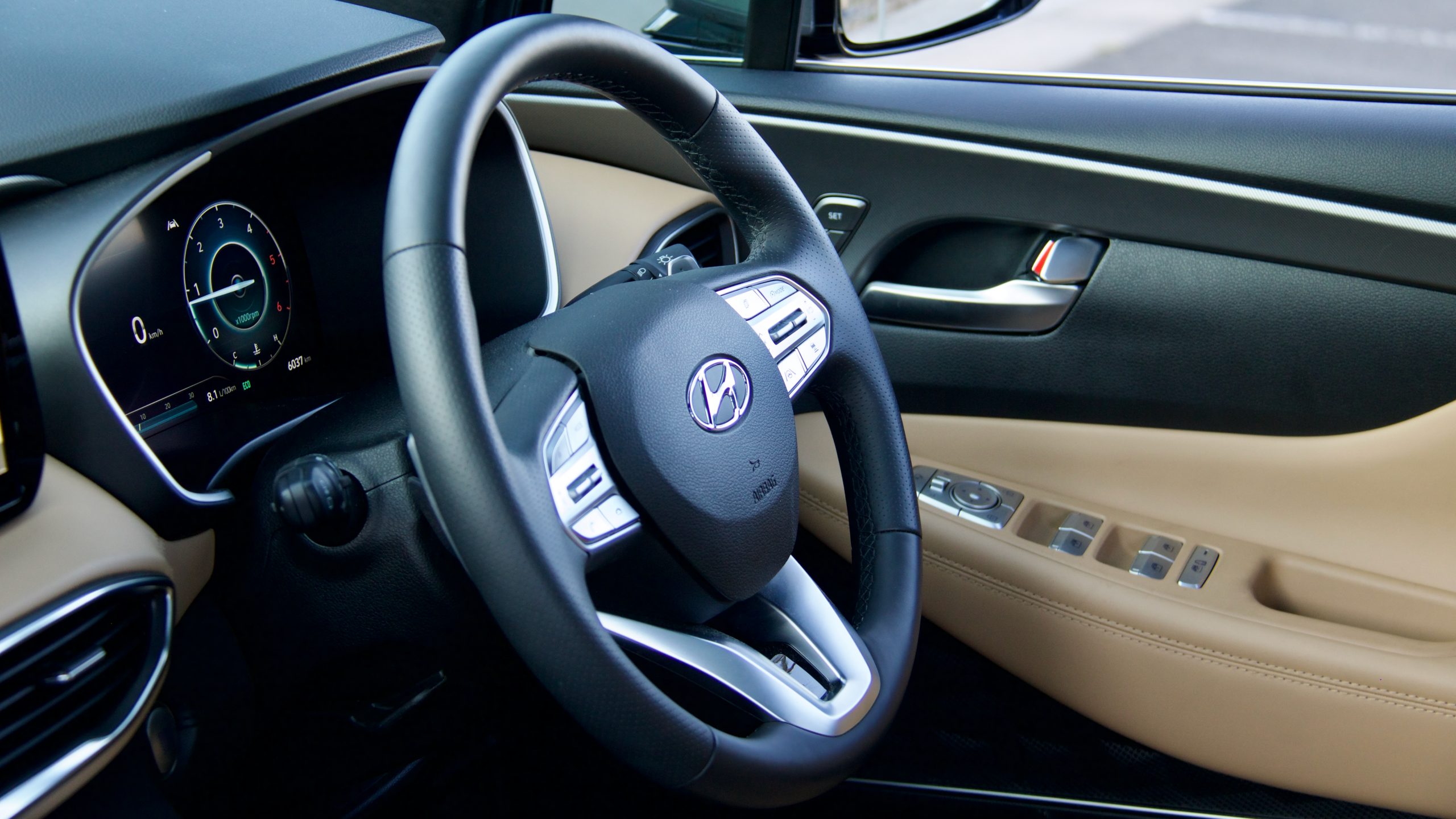
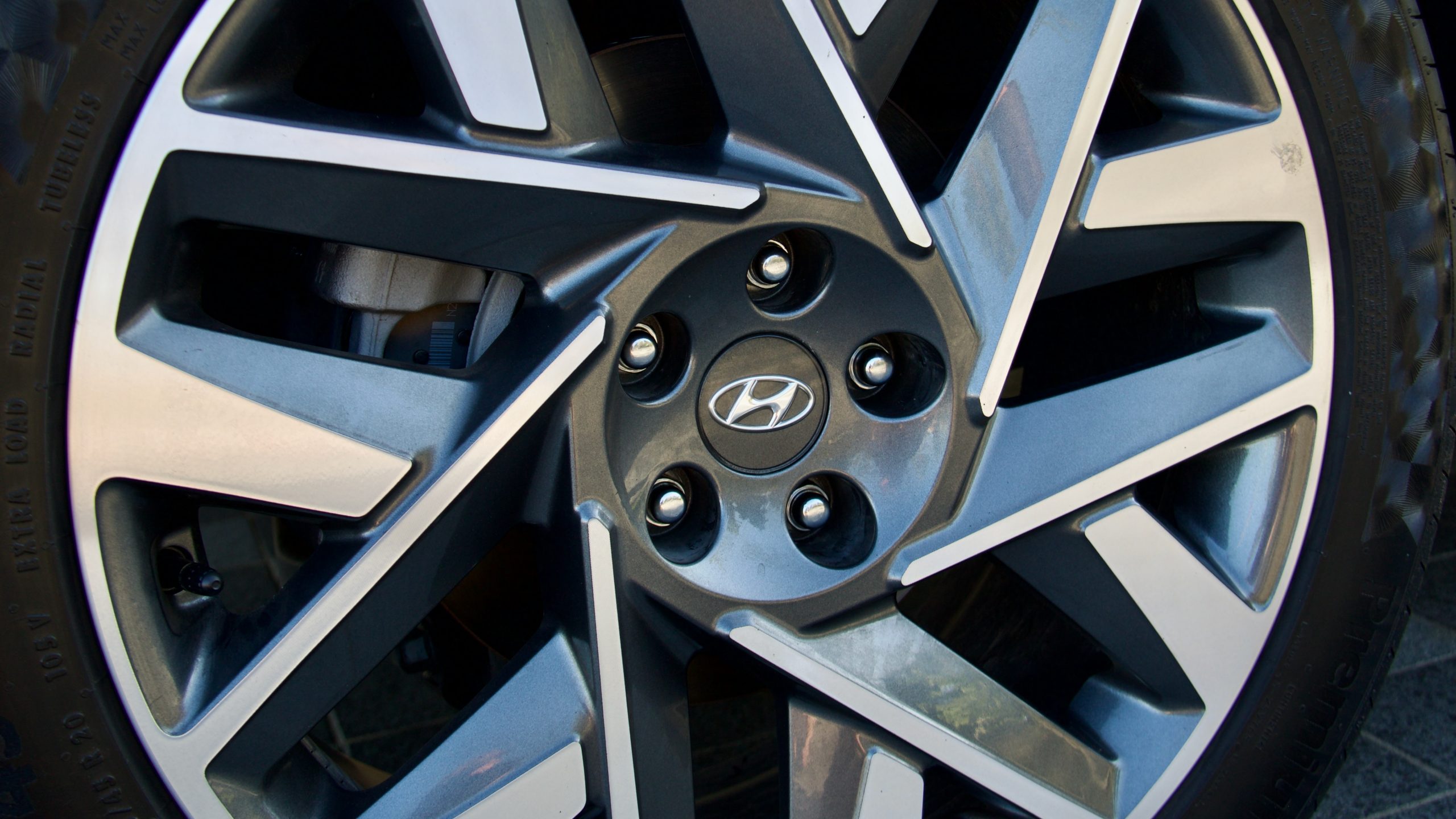
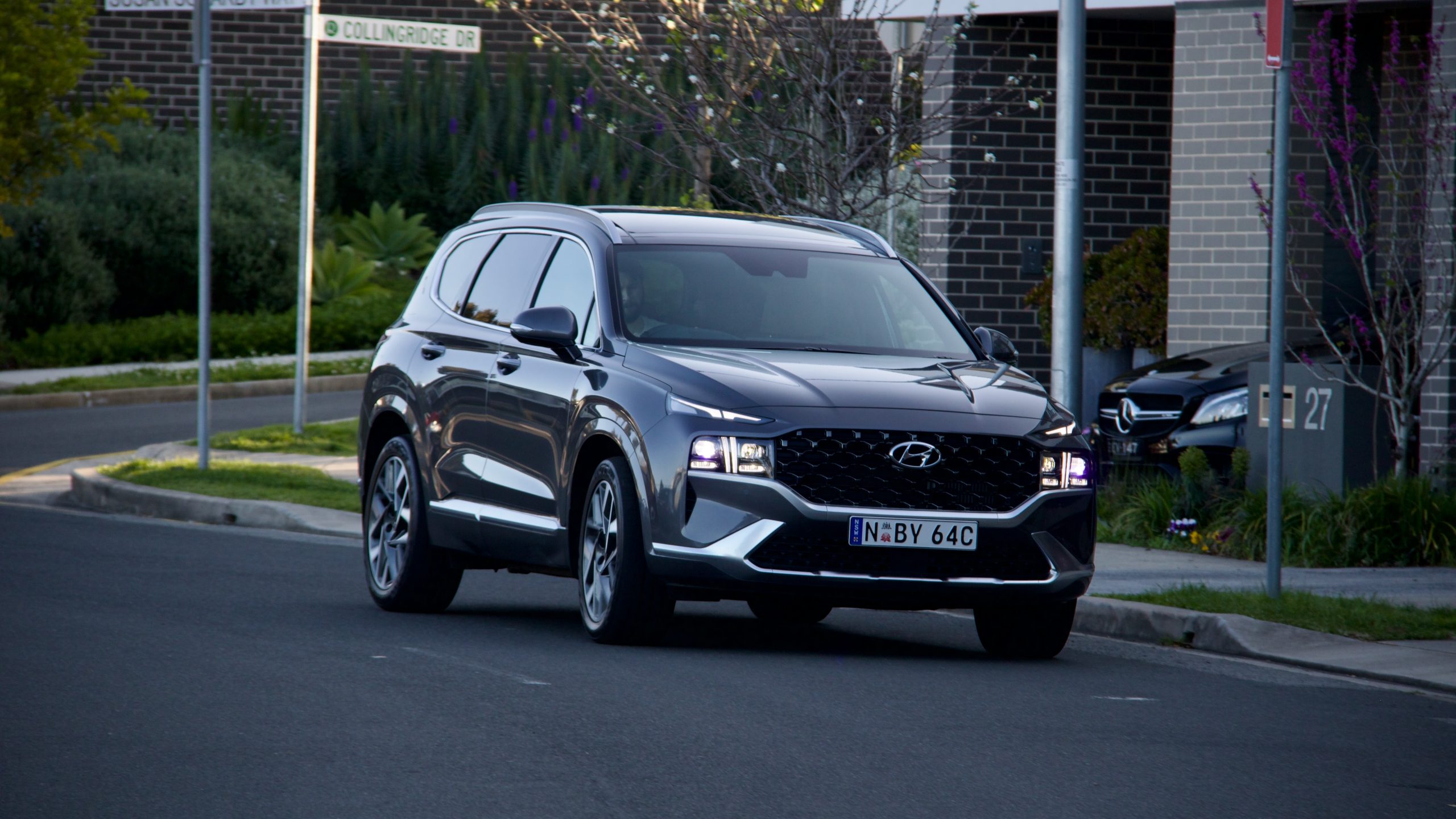
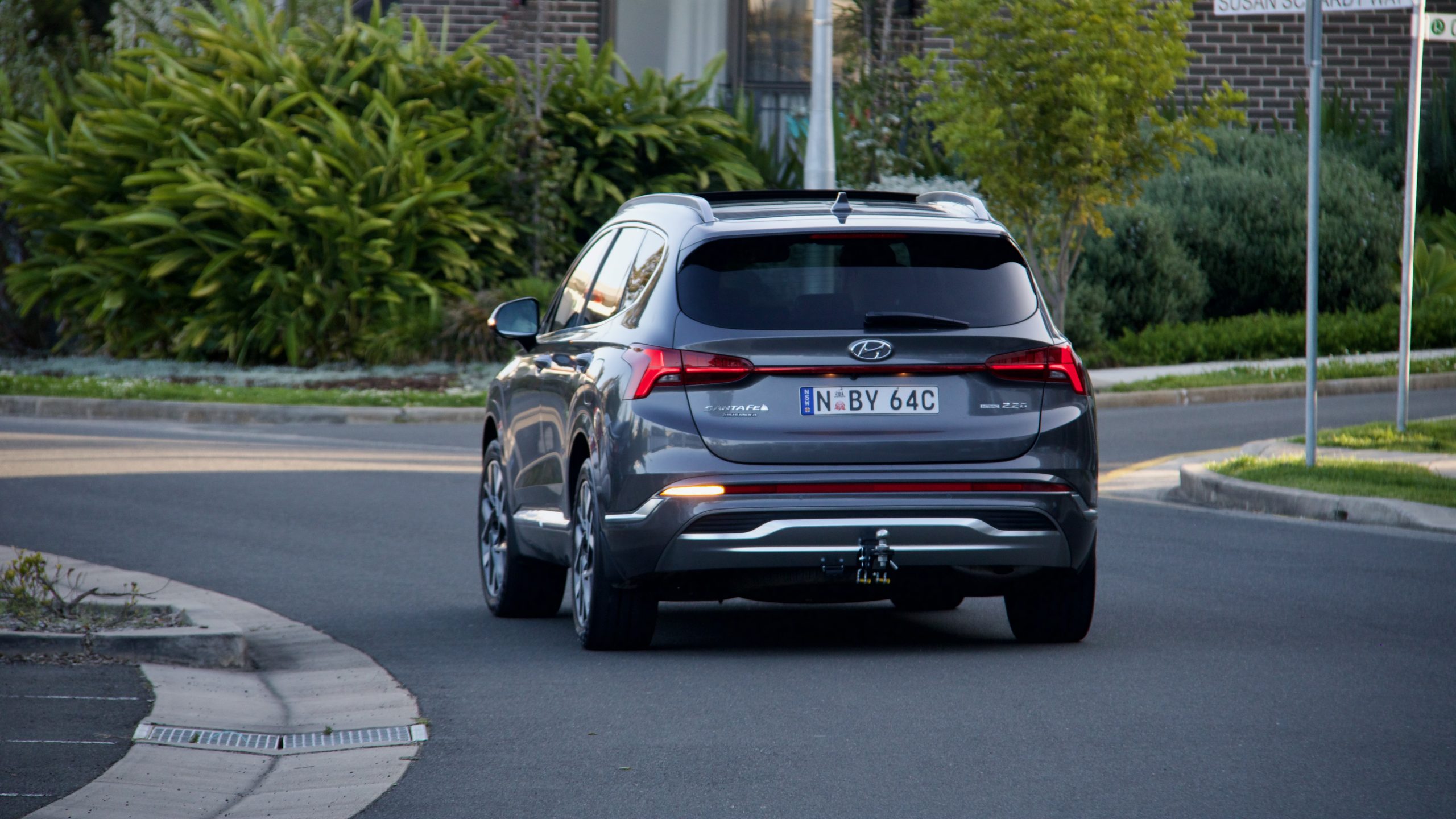
The steering in the Santa Fe is fairly quick, well weighted and light for such a heavy SUV, which makes it feel smaller than its external dimensions would suggest, while weaving around suburbia. That being said, the steering can at times feel a little disconnected from the road, but that’s hardly unusual in this class of vehicle. Visibility is acceptable – while the slope of the rear does constrict rear and rear quarter vision, large side mirrors, and high quality rear vision and 360 degree view cameras do compensate for this to a degree.
Interior & Practicality: 8.5/10
The interior of the 2023 Hyundai Santa Fe Highlander is a modern and plush place to be. It’s by no means at the cutting edge of interior design, but is nothing wrong with that. Our test car was optioned with the tan interior, which is adds a sense of colour. We’re big fans of the colour palette, it feels very classy. Soft touch surfaces abound, with a combination of Nappa and faux leather, both of which feel great to the touch, creating a great ambience and feeling of quality. Switchgear throughout the interior feels great to operate, with good depending and feedback, further adding to the high quality feeling.
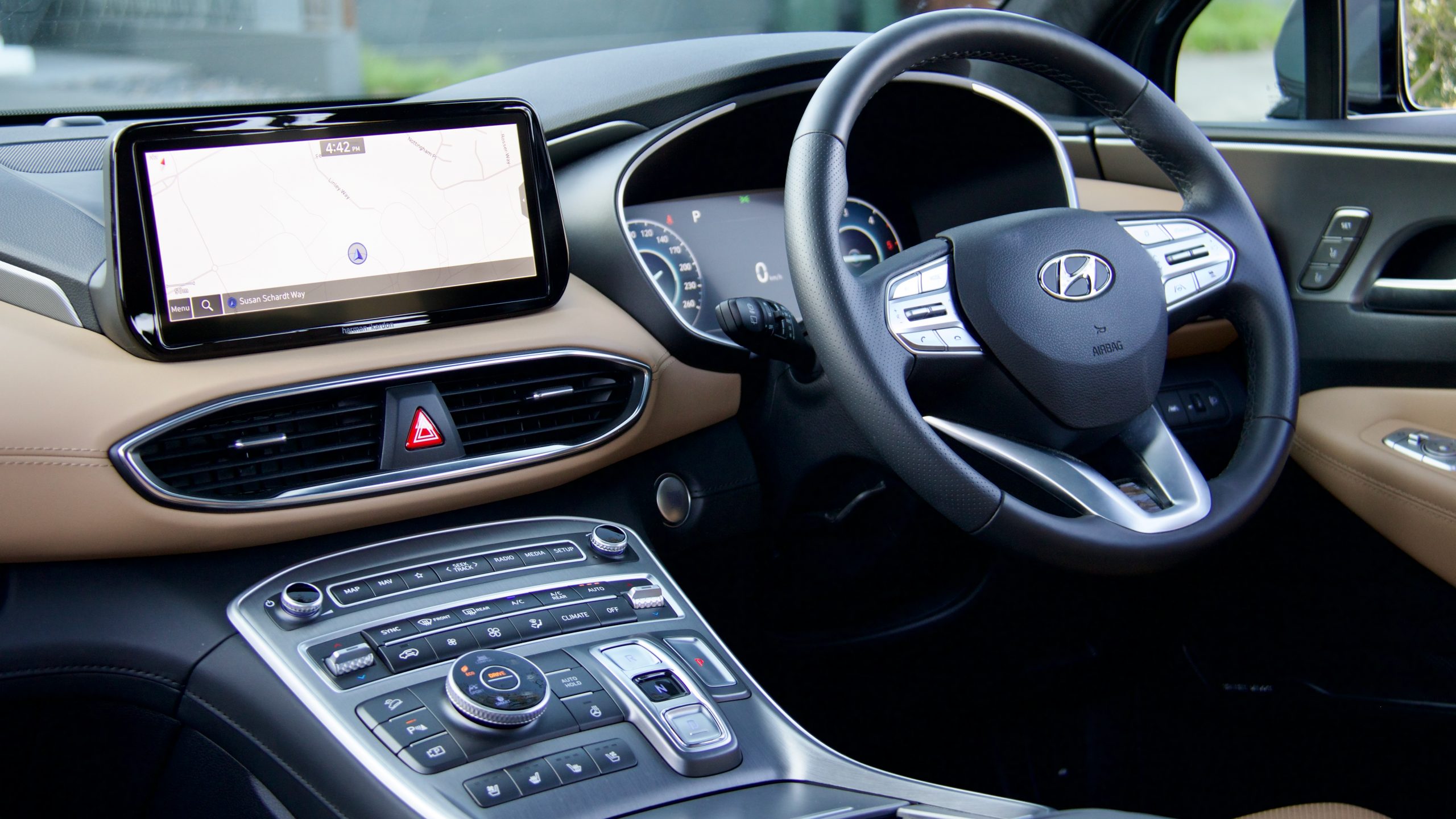
The Nappa leather-trimmed front row feels just as great to sit on, as it does to touch. The seats are very supportive with great bolstering that hugs the driver, and with fourteen ways of adjustment, finding a comfortable position is a breeze. Further increasing the comfort is the heating and ventilation to help keep the front row occupants comfortable no matter the time of year. All of these make front seats are a great place to be on short and long trips alike.
The curvaceous dash meets in a centre bridge that connects to the centre console, which is interesting and adds a point of difference to competitors. The bridge section is decked out with controls, which for the most part are logically placed and grouped. We appreciate Hyundai’s dedication to physical buttons for nearly everything, including climate control and media controls. Our only reservation is with another of Hyundai’s dedications – to push button gear shifters. A solution to a problem that doesn’t really exist, push buttons are far harder to use – while one does get used to them, they are never as quick or easy to to use as traditional shifters, and very difficult to operate without looking down. The location of the parking brake switch also leaves a lot to be desired, being located to the right of the steering wheel instead of the logical place near the gear buttons.
On a more positive note, the large digital instrument cluster is crisp and a joy to look at, though we’d like to see Hyundai introduce more customisability to the cluster to take advantage of the space to show exactly what the driver wants in front of them. The heads-up display is also great and helps the driver to keep their eyes on the road.
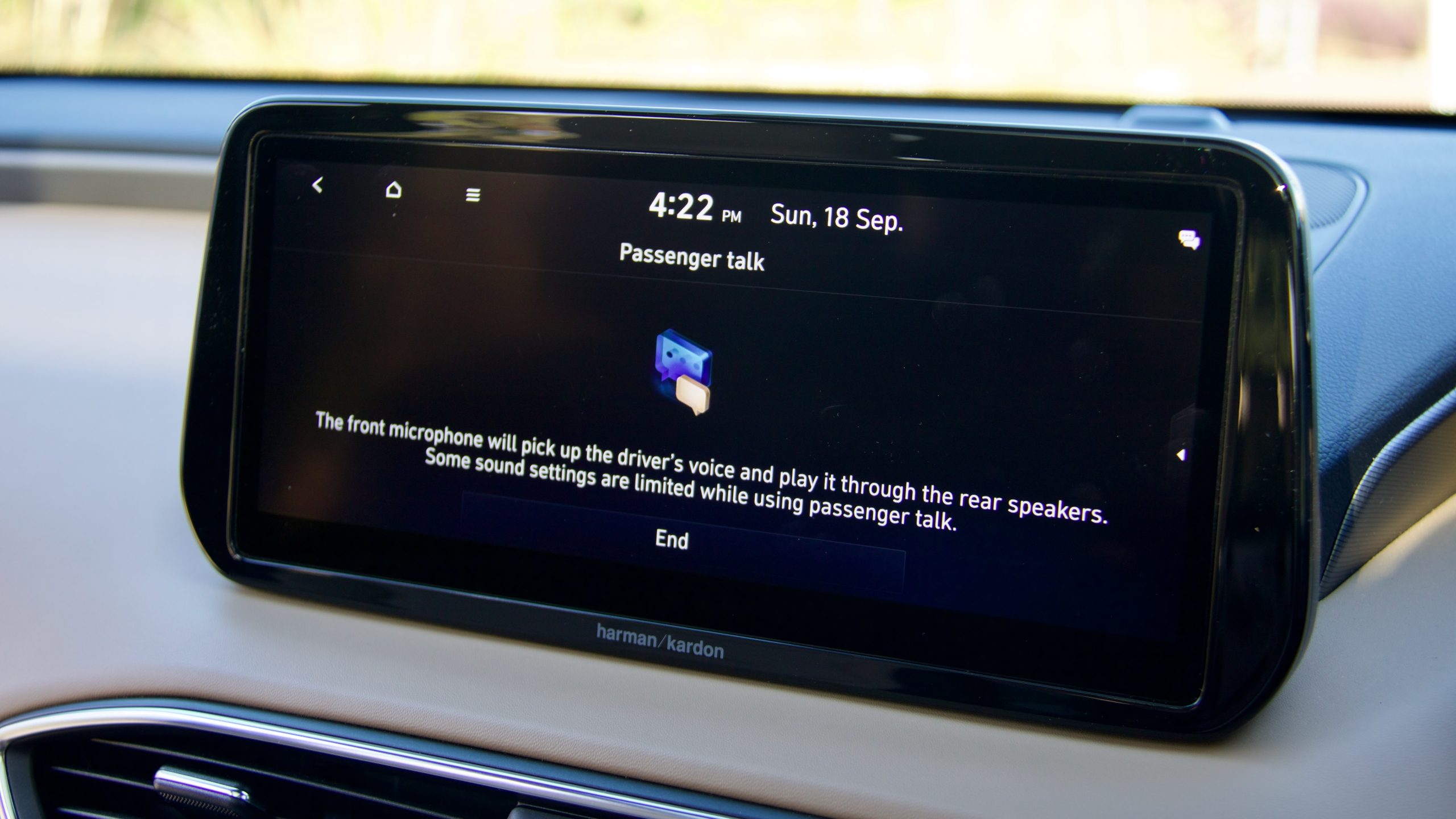
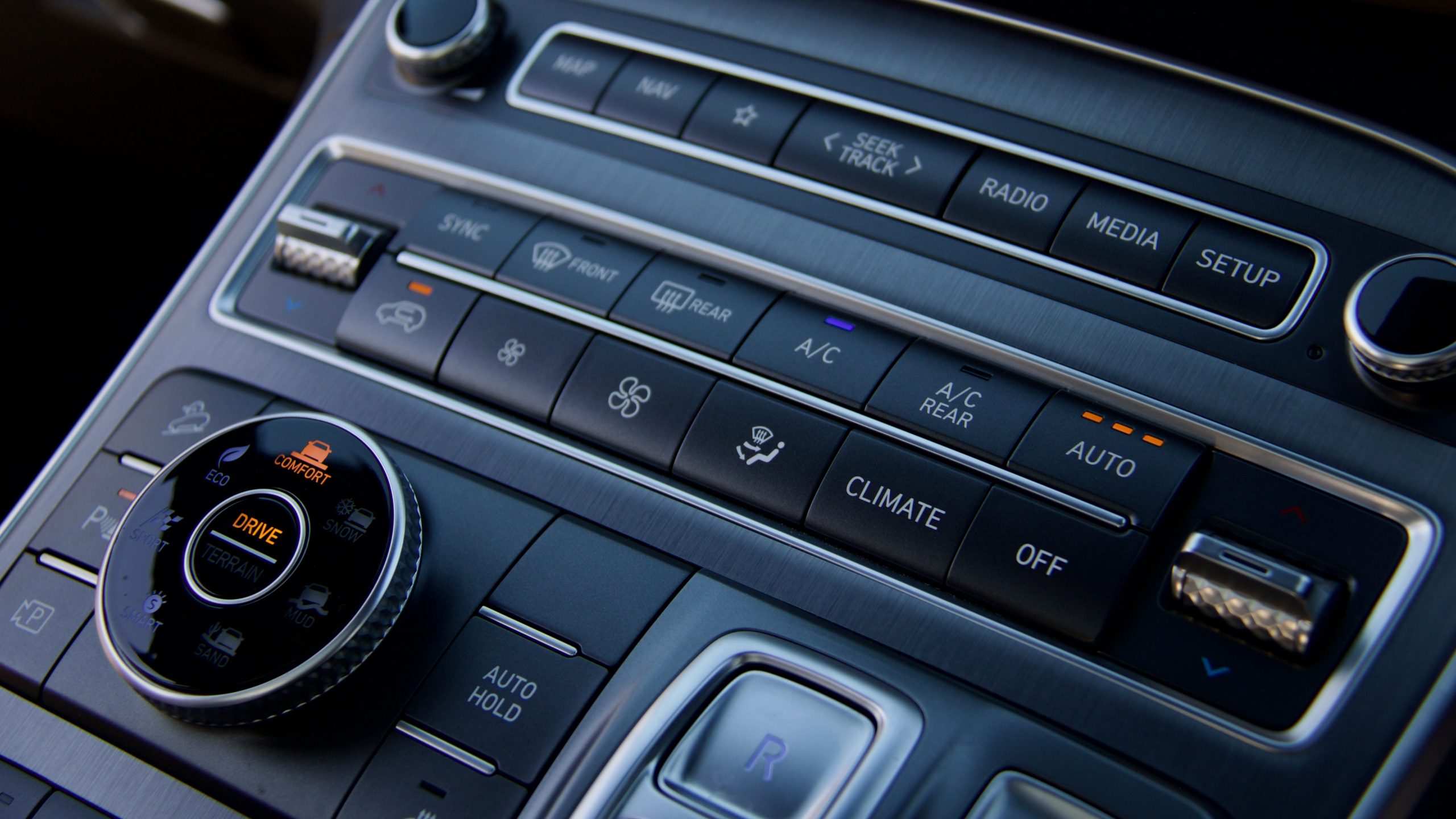
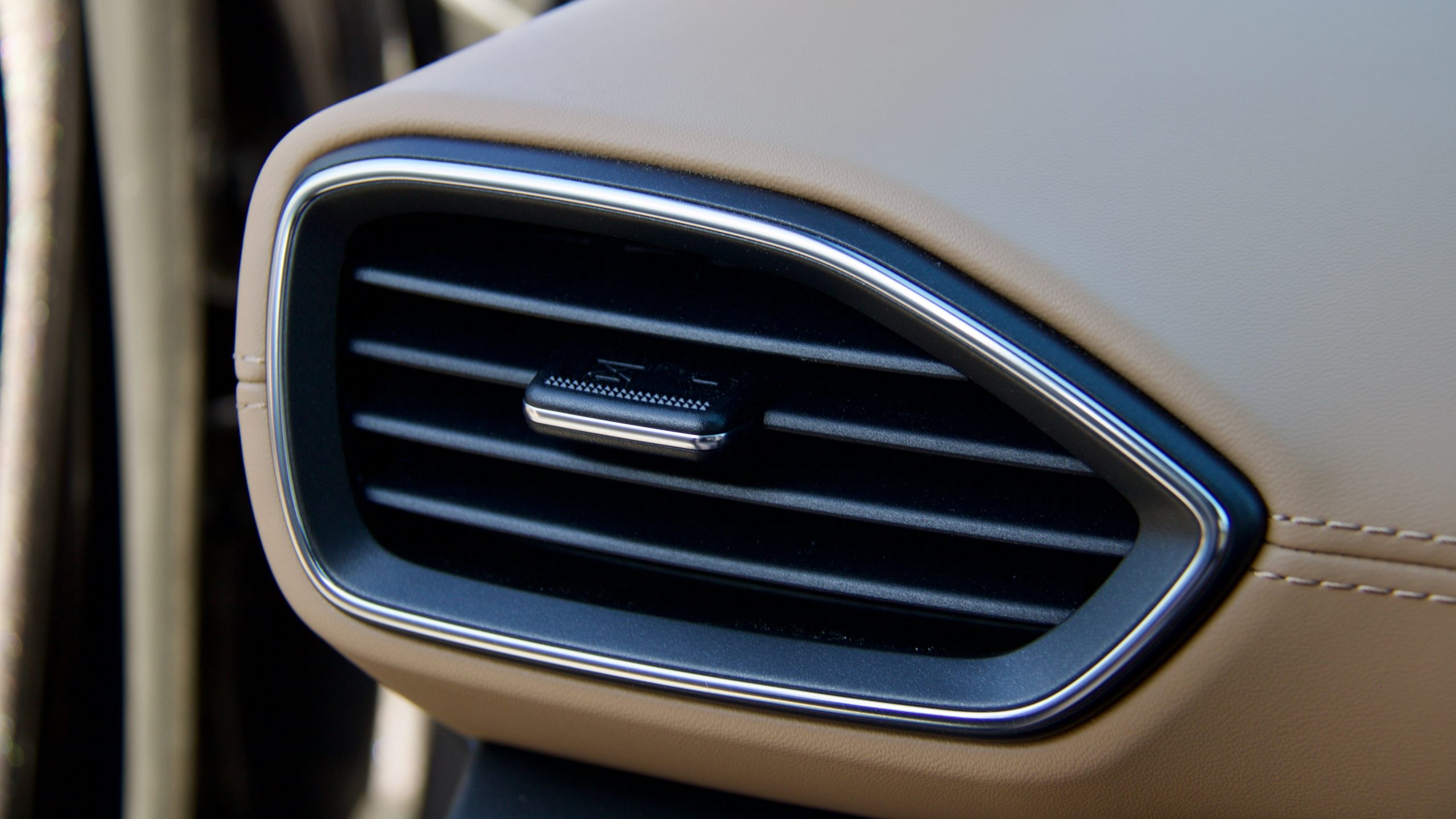
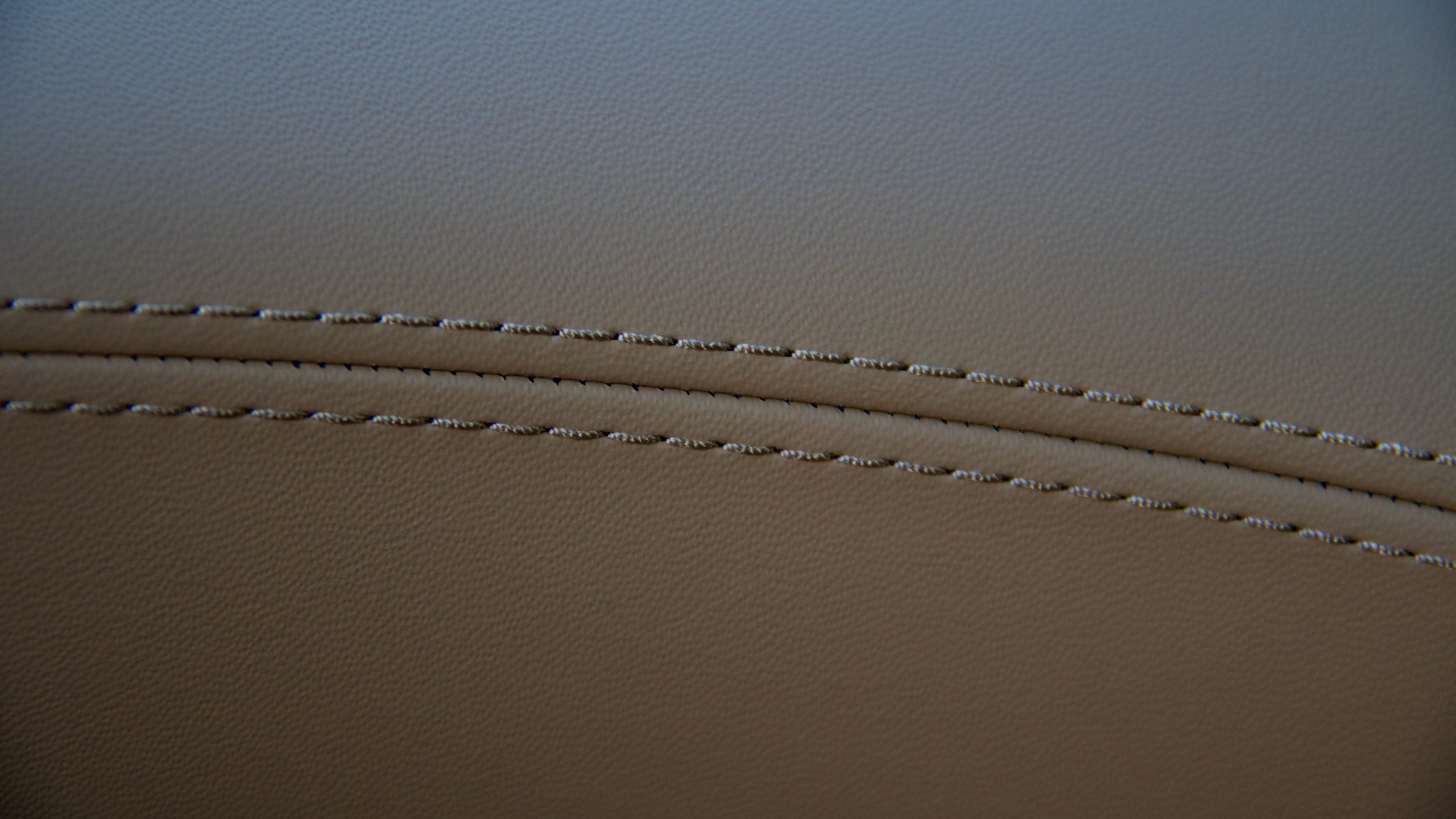
In typical Hyundai style, the infotainment display features high resolution and great fluidity. Hyundai’s software is also modern, very responsive and well featured. Phone mirroring provided by wired Apple CarPlay and Android Auto, and is complimented by the usual AM, FM and digital radio plus satellite navigation with live traffic. Bonus features include ‘passenger talk’ – a microphone system allowing the driver (or front passenger) to have their voice amplified in the second and third rows, plus ‘sounds of nature’, which offers a range of ambient sounds, apparently to create a calming atmosphere while driving. Whether or not these features are a gimmick or useful, we’ll leave up to individual taste. There are a total of seven USB charging ports throughout the cabin and a handy wireless charger upfront as well.
There is plenty of well thought out storage throughout the cabin – the bridge like centre console has a large storage space underneath, plus there is a capacious centre console bin, a large glovebox and a generous number of cupholders scattered through the cabin.
The middle row of the Santa Fe is spacious and comfortable. The seats are quite comfortable and supportive. Three averaged sized adults can sit across the rear row in comfort – children even more so. There is plenty of leg, head and knee room, especially in the two outbound seats. The second row is quite well featured with heating for the two outbound seats, two USB ports, window shades, ISOFIX and tether child seat points and air vents. The only thing really missing, in our opinion, is a separate climate control zone with controls.
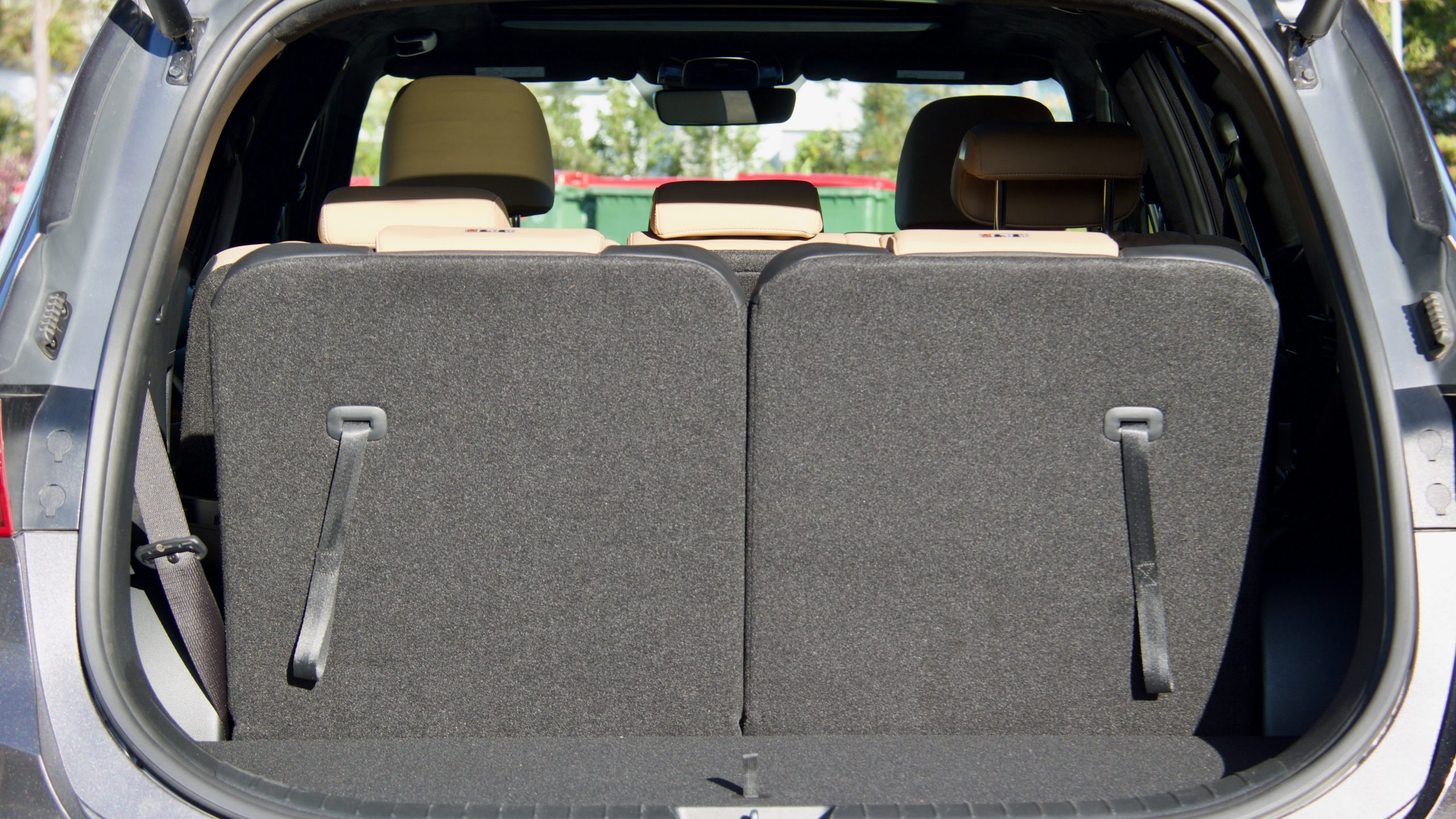
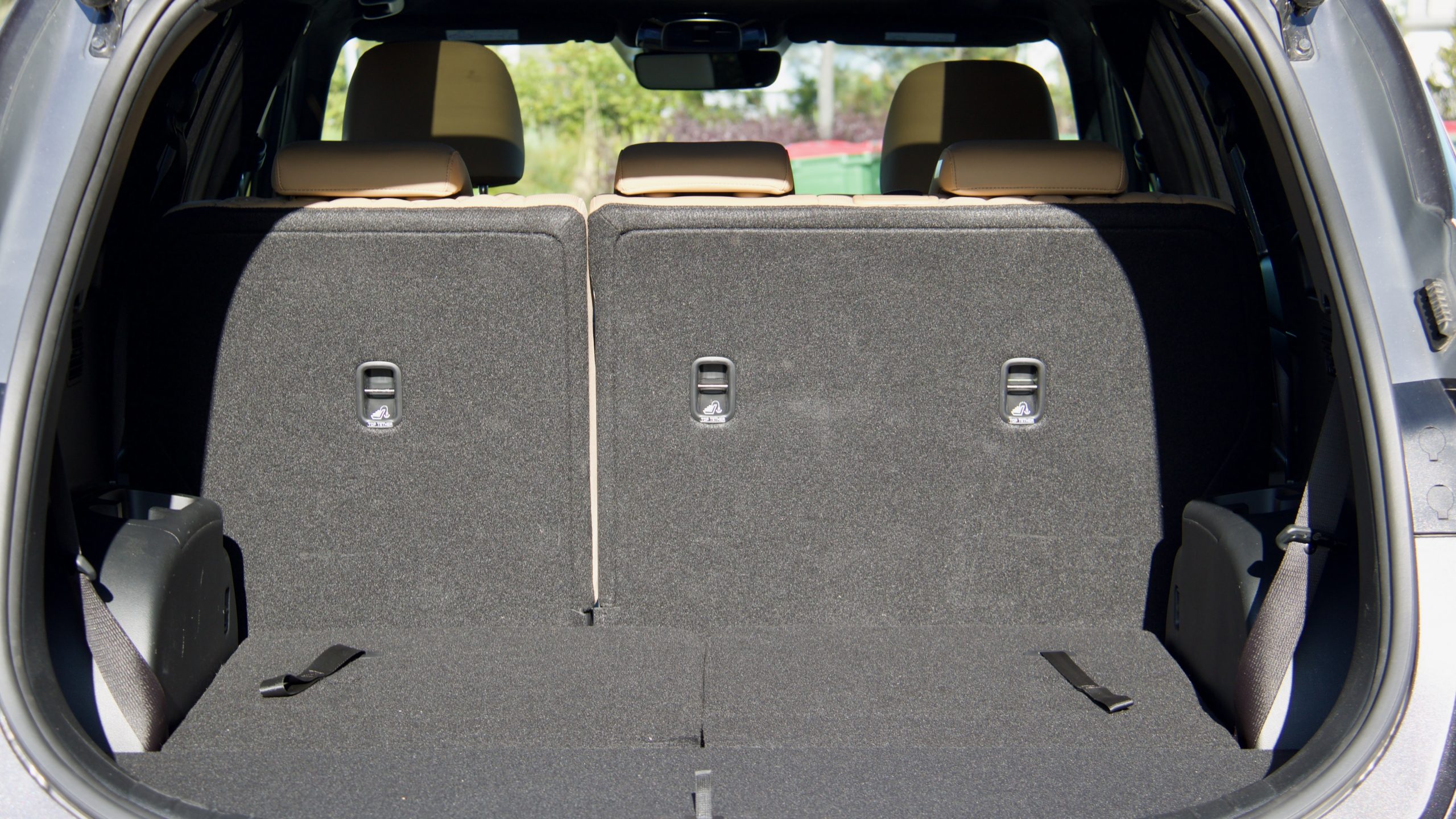
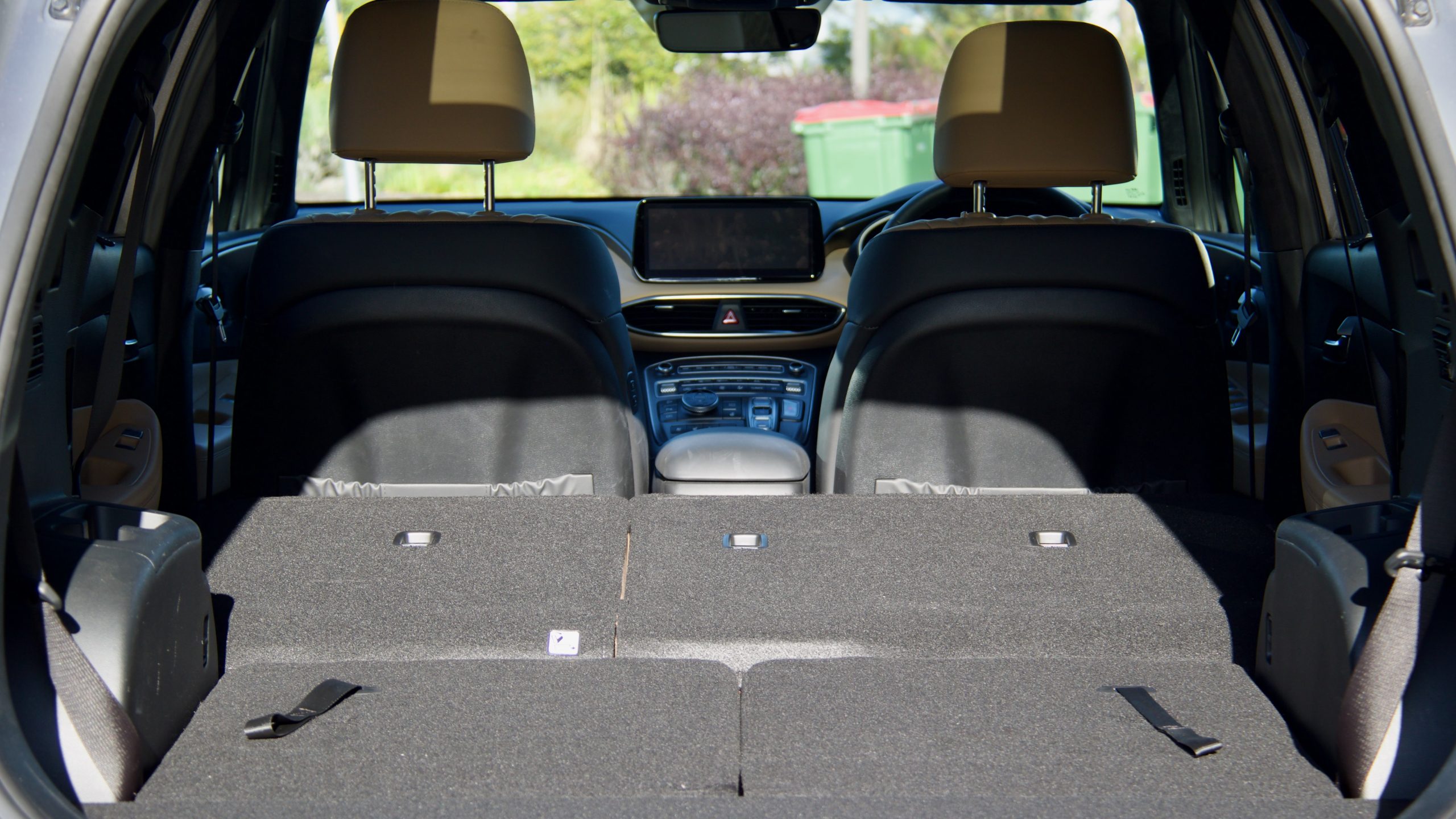
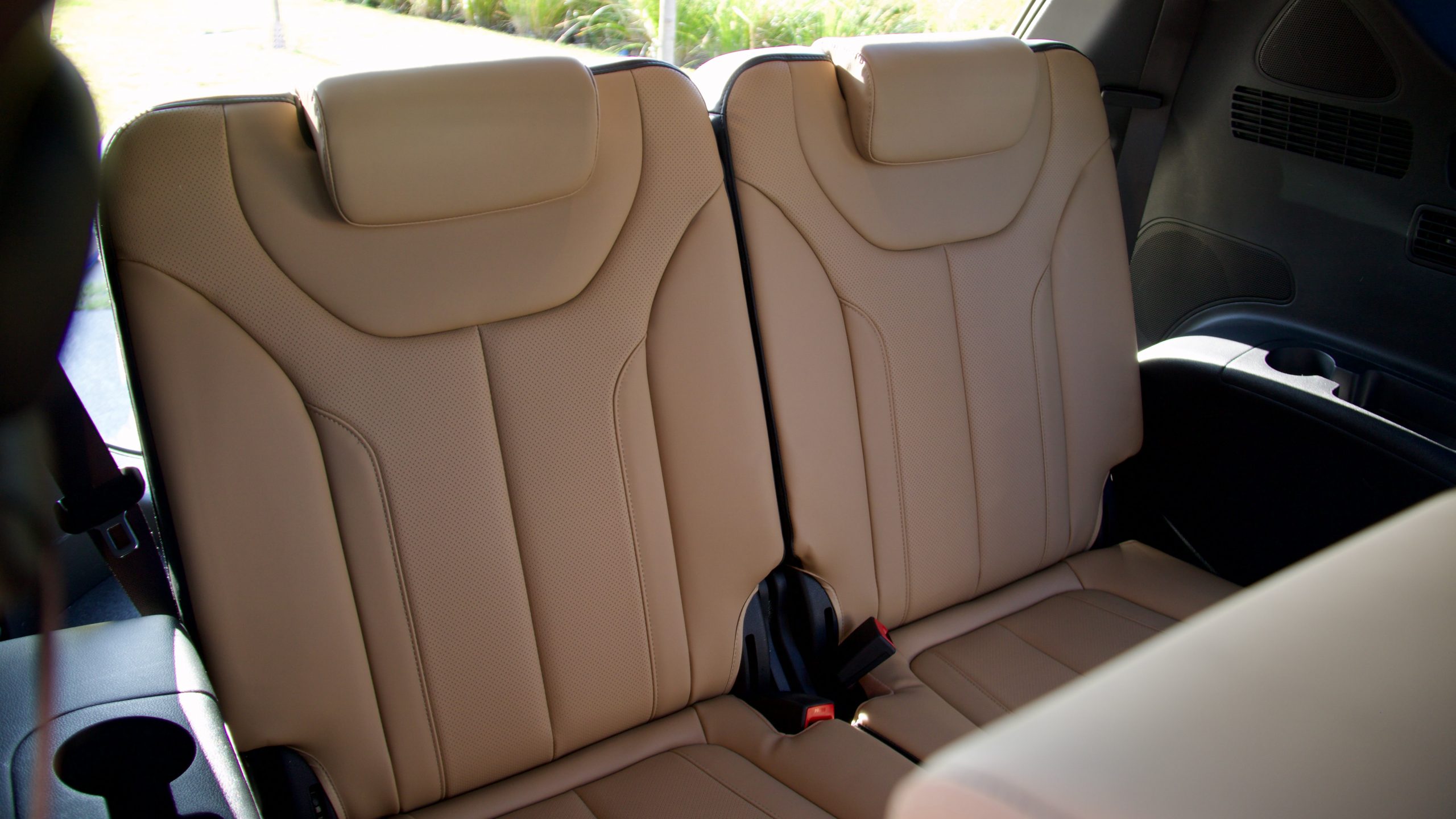
Moving further back, the third row is average for the class in terms of leg and headroom. It’s not a great place for adults, except on short trips – it’s far better suited to children. There are two USB charging ports and air vents with manual fan speed control. The elephant in the room is the lack of airbag coverage for the third row. For those who plan to make frequent usage of the six and seventh seats, we’d suggest looking elsewhere, though if the third row will go unused, this won’t be a consideration.
Opening up the boot of the Santa Fe reveals a cargo area of 130-litres with all seats upright, 571L with the third row folded and a flat floored 1,649L of space with both the second and third rows folded. Speaking of which, with button operated power folding seats, folding the second row is a breeze. This is smaller than both the CX-8, with 209L, 742L and 1727L and the larger Kluger, which has 332L, 658L and 1909L respectively. There is also underfloor storage and a cargo blind. We were happy to find a full-sized spare alloy under the boot floor.
Service & Warranty: 8.5/10
Hyundai covers the 2023 Hyundai Santa Fe Highlander Diesel AWD with a five year/unlimited kilometre warranty, which is matched by Mazda on the CX-8, though slightly bested by the Kluger, with Toyota offering the same base five year, unlimited kilometre warranty, which extends to seven years of coverage for the drivetrain if servicing is carried out by the logbook, and to 10 years for the battery if an annual hybrid battery health check is carried out. The Santa Fe comes with a complimentary 12 months of roadside assistance, which this is extended by 12 months with every scheduled logbook service carried out at a Hyundai dealership, extendable to the life of the car. Mazda includes five years of roadside assistance with the CX-8 regardless of servicing, but with no free extension, and Toyota offers no roadside assistance with the Kluger.
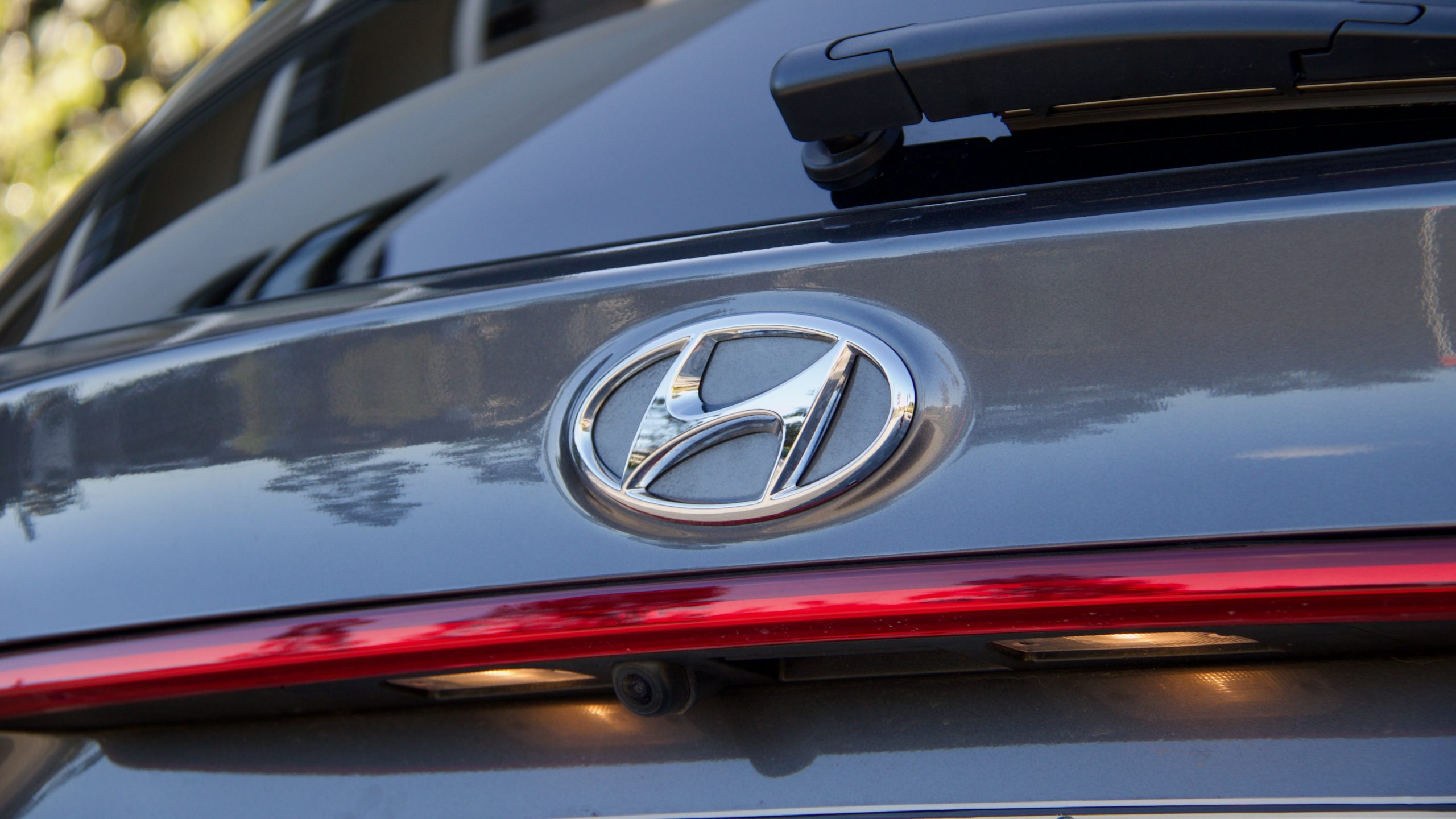
Servicing the Santa Fe over the first five years is capped at a rather expensive $2,495, though it does offer capped price servicing for the ‘lifetime’ of each Santa Fe. Service intervals are every 12 months or 15,000kms. Mazda caps the first five years of servicing for the CX-8 at a slightly lower total cost of $2,376, with a shorter 12 months or 10,000kms service intervals. Servicing the Kluger over the initial five years costs a low $1,325, with identical (to the Santa Fe) intervals of 12 months or 15,000kms.
2023 Hyundai Santa Fe Highlander Diesel AWD Discover Auto Rating: 8.3/10
Hyundai has crafted a brilliant family car in the 2023 Hyundai Santa Fe Highlander Diesel AWD. It’s competent on the road, has a practical, high quality and lovely interior, is priced and equipped sharply and is easy on fuel. We’d definitely pick the diesel option over the V6 petrol, which although is silky smooth, uses nearly amount of fuel each 100kms.
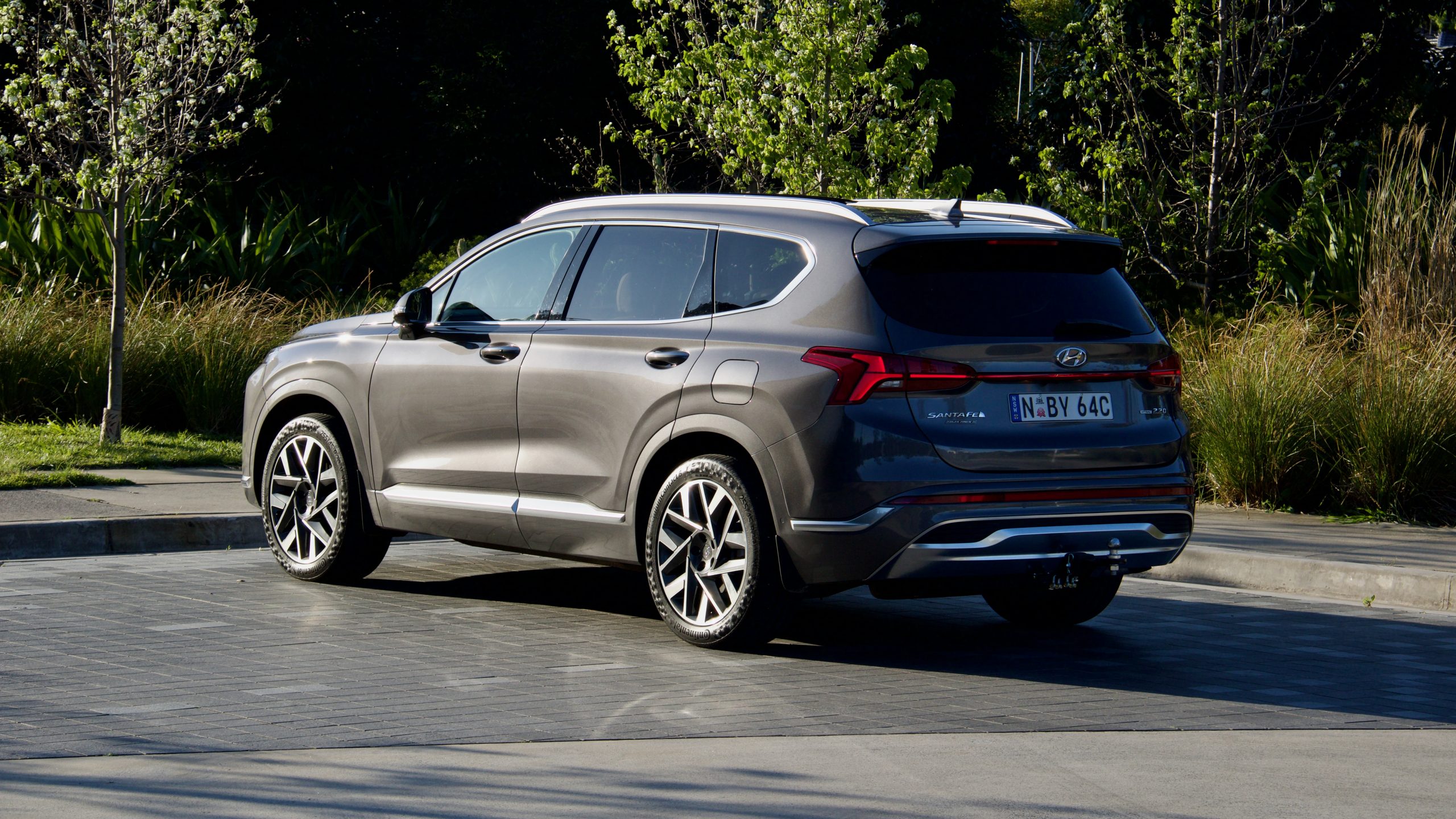
It’s not perfect, however – while the lifetime roadside assistance capped price servicing is attractive, the cost of each service is high, there are some practicality niggles in the interior and the drive isn’t quite as engaging as some rivals, but we don’t think most potential buyers would be too bothered by this. Our biggest qualm is the lack of airbag coverage for the third row – we’d definitely suggest alternatives, even the Santa Fe’s larger Palisade sibling – for those who looking for a seven- or eight-seater. Plenty of buyers will never touch the third row however, so this issue will be moot.
While there are plenty large SUV competitors to the Santa Fe, shoppers would be remiss to not have Hyundai’s large SUV on their test drive list.
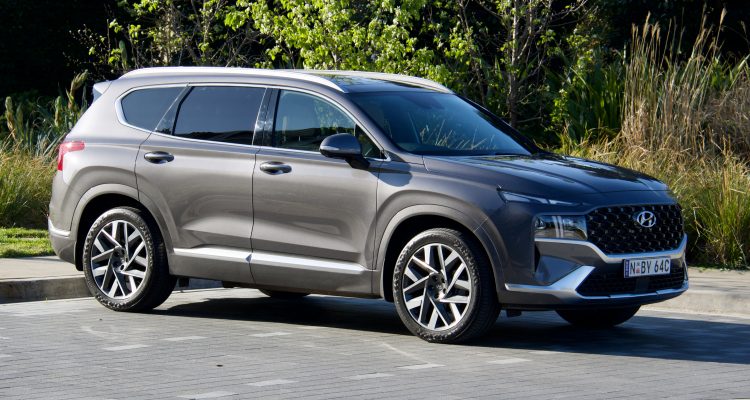
Leave a Reply